News
29.11.2025
Lotus Technology Inc. is pleased to announce the arrival of David Rogers as Head of Corporate Communication.
David will lead PR operations in the UK and Europe across both corporate and product affairs for the luxury mobility provider, reporting to Jingbo Mao, Chief Sales Officer.
With a career in automotive communications stretching back 20 years, David has extensive experience in the sector and has worked with brands such as Harley-Davidson, Honda and Toyota. In his most recent role at Toyota, he led media messaging for Toyota and its luxury stablemate, Lexus, majoring on electrification, hydrogen society and mobility.
David will lead PR operations in the UK and Europe across both corporate and product affairs for the luxury mobility provider, reporting to Jingbo Mao, Chief Sales Officer.
With a career in automotive communications stretching back 20 years, David has extensive experience in the sector and has worked with brands such as Harley-Davidson, Honda and Toyota. In his most recent role at Toyota, he led media messaging for Toyota and its luxury stablemate, Lexus, majoring on electrification, hydrogen society and mobility.

As well as working in-house for some of the biggest automotive brands, David also spent five years in the communications team at the Society of Motor Manufacturers and Traders (SMMT) where he became well-versed in managing sensitive projects and steered communications campaigns with a UK manufacturing angle.
On joining Lotus, he said: “This is an exceptionally exciting time to be joining such a prestigious brand, as it enters its next stage of evolution. I really look forward to sharing the stories of the cutting edge technology I know is coming down the line and how that marries with the rich, hand built UK heritage associated with Lotus.”
David takes up the role immediately and will oversee all corporate and product media relations work for Lotus Technology in the UK and Europe.
On joining Lotus, he said: “This is an exceptionally exciting time to be joining such a prestigious brand, as it enters its next stage of evolution. I really look forward to sharing the stories of the cutting edge technology I know is coming down the line and how that marries with the rich, hand built UK heritage associated with Lotus.”
David takes up the role immediately and will oversee all corporate and product media relations work for Lotus Technology in the UK and Europe.
Quelle: Lotus Cars
18.11.2025
Lotus today has announced Emeya has beaten its own record as one of the fastest-charging electric vehicles (EVs) - using the public charging network.
The test was completed independently by Lotus Al Ghanim, the official dealer of Lotus in Kuwait, and used Lotus’ ultra-fast 450kW DC charger. The car was able to maximise nearly the full capacity of the charger, reaching a peak charging power of 443kW, enabling it to charge from 10 to 80 percent in just 13m35s.
This was achieved in extensive heat conditions in the region, highlighting the durability, reliability and efficiency of both the car and charger.
Lotus is committed to futureproofing its electric cars, so as the charging infrastructure develops, its drivers have the confidence that their vehicles will continue remain excellent for efficiency and capability.
The test was completed independently by Lotus Al Ghanim, the official dealer of Lotus in Kuwait, and used Lotus’ ultra-fast 450kW DC charger. The car was able to maximise nearly the full capacity of the charger, reaching a peak charging power of 443kW, enabling it to charge from 10 to 80 percent in just 13m35s.
This was achieved in extensive heat conditions in the region, highlighting the durability, reliability and efficiency of both the car and charger.
Lotus is committed to futureproofing its electric cars, so as the charging infrastructure develops, its drivers have the confidence that their vehicles will continue remain excellent for efficiency and capability.
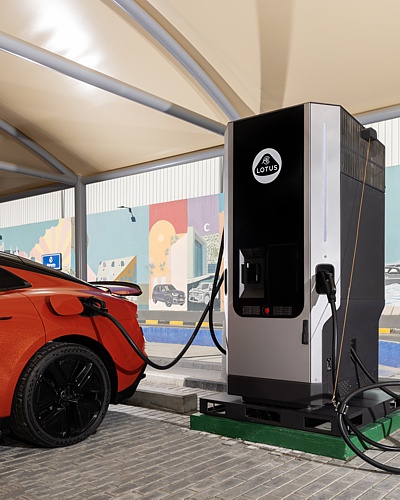
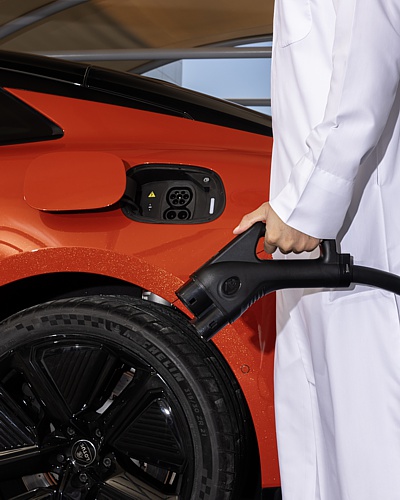
Emeya features a cell-to-pack battery structure, which means that 20 percent more cells can be packaged in the same space compared to a standard module architecture. It also uses a new cooling system architecture that is designed to improve the thermal performance and efficiency of the battery.
The car also has a state-of-the-art 800-volt charging system, which is designed to deliver rapid charging and greater efficiency for drivers, no matter what charger they are using. This technology is also featured in the Lotus Eletre – the company’s hyper-SUV.
Lotus’ ambition is to make it easier than ever to own an EV by providing drivers with the confidence to complete long-distance journeys and go wherever they need to. With a WLTC energy consumption down to 18.7kWh/100km, Emeya delivers up to 310km of range in 10 minutes¹. Additionally, the Emeya 2026 model year features a WTLP range of up to 379 miles (610 km)¹.
The car also has a state-of-the-art 800-volt charging system, which is designed to deliver rapid charging and greater efficiency for drivers, no matter what charger they are using. This technology is also featured in the Lotus Eletre – the company’s hyper-SUV.
Lotus’ ambition is to make it easier than ever to own an EV by providing drivers with the confidence to complete long-distance journeys and go wherever they need to. With a WLTC energy consumption down to 18.7kWh/100km, Emeya delivers up to 310km of range in 10 minutes¹. Additionally, the Emeya 2026 model year features a WTLP range of up to 379 miles (610 km)¹.
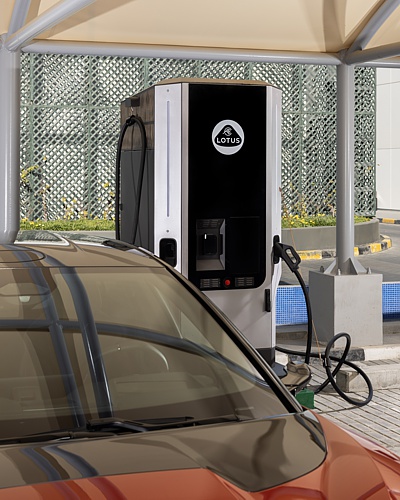
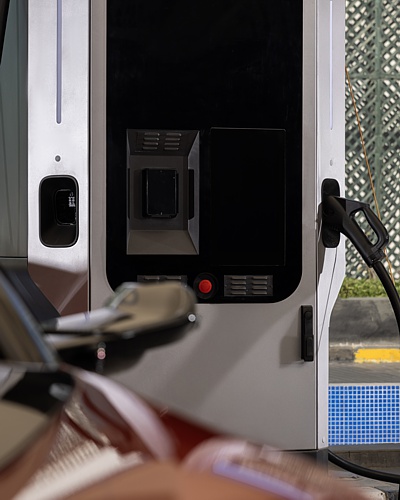
Lotus is delivering a fully integrated charging ecosystem, creating a seamless charging experience with the Lotus Cars app and Lotus HyperOS, the award-winning in-car infotainment system in the Eletre and Emeya². It uses intelligent EV routing to help drivers locate nearby public chargers. This feature reduces range anxiety and can significantly cut travel times. The system can also suggest alternative routes based on the driver’s real-time battery consumption – all delivering an optimised Lotus EV driving experience.
Lotus HyperOS, the award-winning in-car infotainment system in the Eletre and Emeya² also uses intelligent EV routing to help drivers locate nearby public chargers. This feature reduces range anxiety and can significantly cut travel times. The system can also suggest alternative routes based on the driver’s real-time battery consumption – all delivering an optimised Lotus EV driving experience.
Lotus has begun rolling out its ultra-fast 450 kW DC charger in Europe, starting in Germany, and followed by other European markets in the near future.
Emeya is Lotus’ first electric hyper-GT, which set a new benchmark for how a Lotus drives and feels by combining the company’s 75-year expertise in engineering and design, with the latest advanced innovations – bringing drivers an electric car that is exciting to drive and performs exceptionally. For more information, please visit: https://www.lotuscars.com/en-GB/emeya.
¹ In optimal conditions. Charging time may vary depending on a number of factors including charging station power output, battery
health and temperature, and more.
² Lotus HyperOS has won multiple awards including iF Design award 2023.
Lotus HyperOS, the award-winning in-car infotainment system in the Eletre and Emeya² also uses intelligent EV routing to help drivers locate nearby public chargers. This feature reduces range anxiety and can significantly cut travel times. The system can also suggest alternative routes based on the driver’s real-time battery consumption – all delivering an optimised Lotus EV driving experience.
Lotus has begun rolling out its ultra-fast 450 kW DC charger in Europe, starting in Germany, and followed by other European markets in the near future.
Emeya is Lotus’ first electric hyper-GT, which set a new benchmark for how a Lotus drives and feels by combining the company’s 75-year expertise in engineering and design, with the latest advanced innovations – bringing drivers an electric car that is exciting to drive and performs exceptionally. For more information, please visit: https://www.lotuscars.com/en-GB/emeya.
¹ In optimal conditions. Charging time may vary depending on a number of factors including charging station power output, battery
health and temperature, and more.
² Lotus HyperOS has won multiple awards including iF Design award 2023.
Quelle: Lotus Cars
17.09.2025
Lotus announces D.N.A. x DNA, an immersive exhibition opening at the Lotus Mayfair showroom as part of London Design Festival 2025, where Lotus serves as the festival’s official automotive partner.
The showcase explores how the brand’s pioneering design and engineering philosophy, Digital, Natural, Analogue (D.N.A.), has shaped generations of groundbreaking innovations and continues to define the future of performance:
- Digital - representing the immersive, intelligent, and intuitive experience.
- Natural - bringing to life emotional, connected, human-centric design.
- Analogue - Lotus’ continuous advancement of performance engineering.
The showcase explores how the brand’s pioneering design and engineering philosophy, Digital, Natural, Analogue (D.N.A.), has shaped generations of groundbreaking innovations and continues to define the future of performance:
- Digital - representing the immersive, intelligent, and intuitive experience.
- Natural - bringing to life emotional, connected, human-centric design.
- Analogue - Lotus’ continuous advancement of performance engineering.
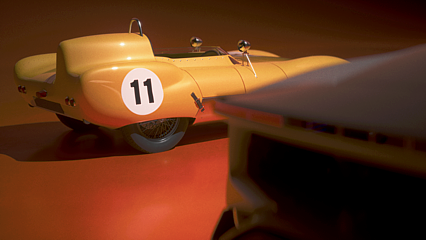

Seamlessly blending together these core design principles with the latest design and engineering innovations, as well as cutting-edge technologies, enables Lotus to simplify and enhance a car’s experience and performance – making it feel like a car you wear.
“This is an important moment for Lotus today. It’s a powerful reminder to everyone of our rich heritage - the design and engineering breakthroughs that have shaped the automotive world and beyond. And its proof that we are still that same pioneering brand. Lotus will always innovate, always push boundaries, and always lead the way,” said Ben Payne, Chief Creative Officer, Lotus Group.
The activation opens a dialogue between heritage and possibility, bringing together experimental materials, prototypes, and projects from Lotus’ archives that embody the brand's relentless innovation, culminating in a raw encounter with the award-winning Lotus Theory 1.
“This is an important moment for Lotus today. It’s a powerful reminder to everyone of our rich heritage - the design and engineering breakthroughs that have shaped the automotive world and beyond. And its proof that we are still that same pioneering brand. Lotus will always innovate, always push boundaries, and always lead the way,” said Ben Payne, Chief Creative Officer, Lotus Group.
The activation opens a dialogue between heritage and possibility, bringing together experimental materials, prototypes, and projects from Lotus’ archives that embody the brand's relentless innovation, culminating in a raw encounter with the award-winning Lotus Theory 1.
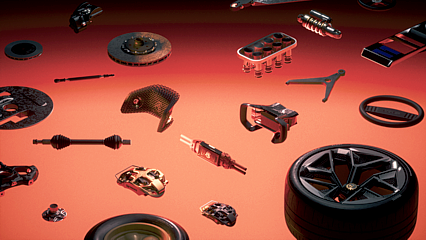

Visitors will have the opportunity to see on display:
- Lotus Eleven
A lightweight icon of motorsport, the Lotus Eleven revolutionised racing in 1956, with its advanced aerodynamics and lightweight aluminium body. Its record-breaking success at Monza and multiple Le Mans class wins cemented Lotus’ reputation for performance through engineering ingenuity.
- Lotus Type 88B
A radical car in Formula 1 at the time. The Type 88B was the first to feature carbon fibre monocoque chassis in 1981, as well as introduced the twin-chassis concept, separating aerodynamic downforce from suspension. Though banned from racing as other teams refused to race against the car, it remains a symbol of Lotus’ fearless pursuit of disruptive ideas in performance engineering, safety and handling.
- Lotus Structure Isolation and Dynamics (SID) Prototype
The SID prototype was a revolutionary experimental research vehicle that combined active and passive suspension technologies to explore advanced vehicle dynamics. Key features included advanced suspension system, dynamic performance and handling, active rear steering, comprehensive data acquisition, and modular suspension mounting. It was the first time that a full understanding of the driver subjective (feel) vs objective (data) could be understood, measured and developed for vehicle dynamics and handling by engineers. The technologies and methodologies developed influenced subsequent Lotus models and contributed to key advancements in the automotive industry.
- Lotus Theory 1
The award-winning design study that encapsulates the Lotus ethos for the future. Theory 1 fuses digital intelligence, natural human-centric design, and analogue performance precision, delivering an experience that is immersive, intuitive, and emotionally engaging.
- Lotus Eleven
A lightweight icon of motorsport, the Lotus Eleven revolutionised racing in 1956, with its advanced aerodynamics and lightweight aluminium body. Its record-breaking success at Monza and multiple Le Mans class wins cemented Lotus’ reputation for performance through engineering ingenuity.
- Lotus Type 88B
A radical car in Formula 1 at the time. The Type 88B was the first to feature carbon fibre monocoque chassis in 1981, as well as introduced the twin-chassis concept, separating aerodynamic downforce from suspension. Though banned from racing as other teams refused to race against the car, it remains a symbol of Lotus’ fearless pursuit of disruptive ideas in performance engineering, safety and handling.
- Lotus Structure Isolation and Dynamics (SID) Prototype
The SID prototype was a revolutionary experimental research vehicle that combined active and passive suspension technologies to explore advanced vehicle dynamics. Key features included advanced suspension system, dynamic performance and handling, active rear steering, comprehensive data acquisition, and modular suspension mounting. It was the first time that a full understanding of the driver subjective (feel) vs objective (data) could be understood, measured and developed for vehicle dynamics and handling by engineers. The technologies and methodologies developed influenced subsequent Lotus models and contributed to key advancements in the automotive industry.
- Lotus Theory 1
The award-winning design study that encapsulates the Lotus ethos for the future. Theory 1 fuses digital intelligence, natural human-centric design, and analogue performance precision, delivering an experience that is immersive, intuitive, and emotionally engaging.
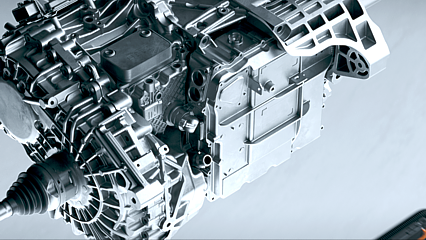

Through Lotus Engineering, the brand’s world-class innovation hub supporting Lotus and customers globally, the exhibition reveals how the Lotus design philosophy transcends the automotive industry, highlighting its global impact.
This includes the iconic Lotus Type 108, from the 1992 Barcelona Olympics. Breaking world records and winning the gold medal ridden by Chris Boardman, the Lotus Type 108 applied the company’s motorsport expertise in aerodynamics, composites and advanced manufacturing methods. Lotus Engineering developed an aerofoil frame design, to deliver a forward force in a cross wind or when the bike was ridden on an oval velodrome, to reduce drag and increase speed. It marked a significant leap forward in bicycle design, and setting the stage for future aerodynamic innovations in the sport.
D.N.A x DNA Exhibition Details
Lotus Mayfair, 73 Piccadilly, London W1J 8HS
13-20 September
Free Admission
For more information, please visit: https://www.lotuscars.com/en-GB/ldf2025
This includes the iconic Lotus Type 108, from the 1992 Barcelona Olympics. Breaking world records and winning the gold medal ridden by Chris Boardman, the Lotus Type 108 applied the company’s motorsport expertise in aerodynamics, composites and advanced manufacturing methods. Lotus Engineering developed an aerofoil frame design, to deliver a forward force in a cross wind or when the bike was ridden on an oval velodrome, to reduce drag and increase speed. It marked a significant leap forward in bicycle design, and setting the stage for future aerodynamic innovations in the sport.
D.N.A x DNA Exhibition Details
Lotus Mayfair, 73 Piccadilly, London W1J 8HS
13-20 September
Free Admission
For more information, please visit: https://www.lotuscars.com/en-GB/ldf2025
Quelle: Lotus Cars
11.09.2025
Lotus at IAA Mobility 2025: Germany Premiere of the Theory 1, Ayrton Senna’s Lotus 99T and current model lineup
Location: Königsplatz, Munich
Germany Premiere: Concept Car Theory 1
Line-up: Lotus 99T, Emira Limited, inspired by the Lotus 99T, Lotus Eletre, Lotus Emeya
Interviews: Ben Payne, Vice President of Design (by appointment)
Lotus will make an impressive appearance at IAA Mobility 2025 at Munich’s Königsplatz. The highlight is the German premiere of the concept car Theory 1, which embodies the future of intelligent sports cars. The presentation is complemented by a tribute to Ayrton Senna with his legendary Lotus 99T F1 car and the exclusive special edition Emira Limited, inspired by the Lotus Type 99T. In addition, the all-electric Hyper-SUV Eletre and the Hyper-GT Emeya complete the model lineup, demonstrating how Lotus seamlessly blends tradition, innovation, and electrification for the future.
Theory 1 – The Design Future of Lotus
Theory 1 is a concept car that reflects the new Lotus design manifesto, “The Lotus Theory,” that will form the foundation for all future Lotus cars, encapsulated through three core principles - Digital, Natural and Analogue (DNA). Digital represents a connected, immersive, and intelligent driving experience. Natural stands for emotional, human-centered design. Analogue symbolizes the continuous development of performance engineering. All three deliver the purist driving experience for which Lotus is known for.
The vehicle features the innovative LOTUSWEAR™ driver system, which interacts in real time with both driver and passengers. Combined with sustainable materials, minimalist design, and a central driver’s seat, Theory 1 sets new standards for intuitive operation, comfort, and driving dynamics.
Germany Premiere: Concept Car Theory 1
Line-up: Lotus 99T, Emira Limited, inspired by the Lotus 99T, Lotus Eletre, Lotus Emeya
Interviews: Ben Payne, Vice President of Design (by appointment)
Lotus will make an impressive appearance at IAA Mobility 2025 at Munich’s Königsplatz. The highlight is the German premiere of the concept car Theory 1, which embodies the future of intelligent sports cars. The presentation is complemented by a tribute to Ayrton Senna with his legendary Lotus 99T F1 car and the exclusive special edition Emira Limited, inspired by the Lotus Type 99T. In addition, the all-electric Hyper-SUV Eletre and the Hyper-GT Emeya complete the model lineup, demonstrating how Lotus seamlessly blends tradition, innovation, and electrification for the future.
Theory 1 – The Design Future of Lotus
Theory 1 is a concept car that reflects the new Lotus design manifesto, “The Lotus Theory,” that will form the foundation for all future Lotus cars, encapsulated through three core principles - Digital, Natural and Analogue (DNA). Digital represents a connected, immersive, and intelligent driving experience. Natural stands for emotional, human-centered design. Analogue symbolizes the continuous development of performance engineering. All three deliver the purist driving experience for which Lotus is known for.
The vehicle features the innovative LOTUSWEAR™ driver system, which interacts in real time with both driver and passengers. Combined with sustainable materials, minimalist design, and a central driver’s seat, Theory 1 sets new standards for intuitive operation, comfort, and driving dynamics.

“With Theory 1, we’ve built on everything Lotus has achieved so far in its 77-year history, to push the boundaries for what it means to drive a performance vehicle. We want to demonstrate that you don’t need to compromise – with both digital and analogue capabilities working harmoniously in the future car. In doing this, we are able to bring drivers the best possible immersive driving experience with raw emotion, functionality and connectivity, at the core,” explains Ben Payne, Vice President of Design at Lotus. Media representatives can arrange exclusive interviews with Payne at the Lotus stand.
Motorsport Heritage Inspires Sports Car Design: Ayrton Senna’s Lotus 99T and Emira Limited, inspired by the Lotus Type 99T
At IAA, Lotus bridges its rich history with the future. The original Lotus 99T F1 car, with which Ayrton Senna won in Monaco and Detroit in 1987, will be a special highlight at the show. Complementing this, Lotus will present the Emira Limited, inspired by the Lotus Type 99T, featuring a yellow paint scheme with blue accents that reference the legendary race car. Only twelve vehicles worldwide are available in this special livery. Both models embody the brand’s heritage and innovative spirit in motorsport.
All-Electric Performance Cars: Hyper-SUV Eletre and Hyper-GT Emeya
Lotus will also showcase its all-electric models at IAA. The Hyper-SUV Lotus Eletre combines outstanding performance of up to 918 hp with the highest level of comfort. Advanced driver assistance systems and a range of up to 600 kilometers ensure sporty driving dynamics over long distances. The four-door Hyper-GT Lotus Emeya accelerates from 0 to 100 km/h in just 2.78 seconds, reaches speeds of up to 256 km/h, and combines luxurious comfort with Lotus’s sporting DNA. Both models demonstrate how Lotus merges sports car heritage with luxurious electrification.
With the presentation of the Theory 1, historic and sports Lotus models, and the all-electric lineup, Lotus at IAA Mobility 2025 once again underscores the brand’s vision for the future: uniting performance, innovation, and design while carrying the thrill of driving into the future – all in line with the motto “Are you a Driver or What?”.
Motorsport Heritage Inspires Sports Car Design: Ayrton Senna’s Lotus 99T and Emira Limited, inspired by the Lotus Type 99T
At IAA, Lotus bridges its rich history with the future. The original Lotus 99T F1 car, with which Ayrton Senna won in Monaco and Detroit in 1987, will be a special highlight at the show. Complementing this, Lotus will present the Emira Limited, inspired by the Lotus Type 99T, featuring a yellow paint scheme with blue accents that reference the legendary race car. Only twelve vehicles worldwide are available in this special livery. Both models embody the brand’s heritage and innovative spirit in motorsport.
All-Electric Performance Cars: Hyper-SUV Eletre and Hyper-GT Emeya
Lotus will also showcase its all-electric models at IAA. The Hyper-SUV Lotus Eletre combines outstanding performance of up to 918 hp with the highest level of comfort. Advanced driver assistance systems and a range of up to 600 kilometers ensure sporty driving dynamics over long distances. The four-door Hyper-GT Lotus Emeya accelerates from 0 to 100 km/h in just 2.78 seconds, reaches speeds of up to 256 km/h, and combines luxurious comfort with Lotus’s sporting DNA. Both models demonstrate how Lotus merges sports car heritage with luxurious electrification.
With the presentation of the Theory 1, historic and sports Lotus models, and the all-electric lineup, Lotus at IAA Mobility 2025 once again underscores the brand’s vision for the future: uniting performance, innovation, and design while carrying the thrill of driving into the future – all in line with the motto “Are you a Driver or What?”.
Quelle: Lotus Cars
08.07.2025
... Present And Future.
- The groundbreaking Lotus Theory 1 concept car will take pride of place on the Lotus stand for its Goodwood debut.
- Lotus celebrates its role in F1 history, as part of the 75 years of Formula 1 anniversary, with tributes to racing legends Ayrton
Senna and Jim Clark.
- The return of Team Lotus, a global community bringing together passionate racers and fans who share a love for motorsport,
personified in the Emira GT4 car on the stand, and Emira Cup Concept running dynamically throughout the event.
- Lotus celebrates its role in F1 history, as part of the 75 years of Formula 1 anniversary, with tributes to racing legends Ayrton
Senna and Jim Clark.
- The return of Team Lotus, a global community bringing together passionate racers and fans who share a love for motorsport,
personified in the Emira GT4 car on the stand, and Emira Cup Concept running dynamically throughout the event.
With debuts, dynamic displays and a celebration of 75 years of F1 legacy, Lotus is set to return to the 2025 Goodwood Festival of Speed with an immersive line up, bringing together the most comprehensive Lotus showcase from its past, present, and future.
Theory 1 will make its Goodwood debut this year. The concept car is Lotus' showcase of the brand's vision for the future, focusing on innovative design and groundbreaking technology, and will take pride of place on the show stand.
Ben Payne, Vice President of Design, Lotus Group said: “Theory 1 represents the next chapter for Lotus, and we’re thrilled to show the car during the event. This concept builds on everything Lotus has achieved in its 77-year history, to push the boundaries for what it means to drive a performance vehicle. We want to demonstrate that you don’t need to compromise – with both digital and analogue capabilities working harmoniously in the future car. In doing this, we can bring drivers the best possible immersive driving experience with raw emotion, functionality and connectivity, at the core.”
As Goodwood celebrates 75 years of Formula 1, Lotus will pay tribute to its own F1 icons. On display, the Lotus Type 33, driven by Jim Clark to his F1 title in 1965, and the Lotus 97T. in which Ayrton Senna took his first F1 victory. Fans can join Clive Chapman, Managing Director of Classic Team Lotus, and Chris Dinnage, Classic Team Lotus Team Manager (who also served as number one mechanic for Ayrton Senna) for exclusive interviews and personal reflections on both drivers. These sessions will take place on the Lotus stand, Saturday and Sunday at 12.30.
Theory 1 will make its Goodwood debut this year. The concept car is Lotus' showcase of the brand's vision for the future, focusing on innovative design and groundbreaking technology, and will take pride of place on the show stand.
Ben Payne, Vice President of Design, Lotus Group said: “Theory 1 represents the next chapter for Lotus, and we’re thrilled to show the car during the event. This concept builds on everything Lotus has achieved in its 77-year history, to push the boundaries for what it means to drive a performance vehicle. We want to demonstrate that you don’t need to compromise – with both digital and analogue capabilities working harmoniously in the future car. In doing this, we can bring drivers the best possible immersive driving experience with raw emotion, functionality and connectivity, at the core.”
As Goodwood celebrates 75 years of Formula 1, Lotus will pay tribute to its own F1 icons. On display, the Lotus Type 33, driven by Jim Clark to his F1 title in 1965, and the Lotus 97T. in which Ayrton Senna took his first F1 victory. Fans can join Clive Chapman, Managing Director of Classic Team Lotus, and Chris Dinnage, Classic Team Lotus Team Manager (who also served as number one mechanic for Ayrton Senna) for exclusive interviews and personal reflections on both drivers. These sessions will take place on the Lotus stand, Saturday and Sunday at 12.30.

Clive Chapman said: “2025 marks the 40th anniversary of Ayrton Senna’s first F1 victory at Estoril with Team Lotus, a defining moment for both team and driver. We also celebrated the 60th anniversary of Jim Clark’s unrivalled year of winning the Formula 1 World championship, Indianapolis 500, Tasman Series and the Formula 2 Championship. The talent, technical understanding and passion of both drivers helped push Team Lotus to such great achievements. I am sure the fans at Goodwood will enjoy seeing these iconic cars and listening to our personal insights into the careers of two of the greatest drivers in the 75 years of F1.”
Team Lotus is back and will debut its Emira Cup racer. The car is heavily based on the road-going Emira sports car and is designed to take enthusiasts and beginner racers through the ladder from first track days to full competition in Lotus Cup series around the world.
The current Lotus lineup, Evija, Emeya, Eletre and Emira will all be participating in daily dynamic hill runs, and visitors will be able to explore these models in more detail on the Lotus stand, with product specialists on hand to support.
Team Lotus is back and will debut its Emira Cup racer. The car is heavily based on the road-going Emira sports car and is designed to take enthusiasts and beginner racers through the ladder from first track days to full competition in Lotus Cup series around the world.
The current Lotus lineup, Evija, Emeya, Eletre and Emira will all be participating in daily dynamic hill runs, and visitors will be able to explore these models in more detail on the Lotus stand, with product specialists on hand to support.

Throughout the weekend, the Lotus stand will be a hub of activity, featuring daily Q&As hosted by renowned journalist and presenter, Natasha Bird. Natasha will be quizzing guests on their experience and lead important discussions about how we bring the joy of racing into a more inclusive era.
Natasha said: “I’m looking forward to hosting a series of discussions on the Lotus stand again this year. We’ll dive into Lotus’ incredible heritage of racing passion and innovation in motorsport and also explore how the industry is moving towards a more inclusive future."
Natasha said: “I’m looking forward to hosting a series of discussions on the Lotus stand again this year. We’ll dive into Lotus’ incredible heritage of racing passion and innovation in motorsport and also explore how the industry is moving towards a more inclusive future."

LIVE ON THE STAND
Visitors can enjoy daily Lotus Moments at 11:00 and 15:00 on the Lotus stand, a family-friendly experience full of energy, sound, and surprise.
On Thursday, join us at 11:30 and 14:00 for conversations with Lotus spokespeople, exploring the brand’s DNA and its journey through time. Then on Friday at 14:00, don’t miss a special panel on how we can support inclusion in motorsport from an early age, presented in partnership with Race for Diversity and Inclusion.
Lotus will honour two of the greatest drivers in motorsport history, Jim Clark and Ayrton Senna, with a tribute to their racing legacy and the iconic Team Lotus era. On Saturday and Sunday at 12:30, join Clive Chapman for exclusive interviews and personal memories of these F1 heroes.
Visitors can enjoy daily Lotus Moments at 11:00 and 15:00 on the Lotus stand, a family-friendly experience full of energy, sound, and surprise.
On Thursday, join us at 11:30 and 14:00 for conversations with Lotus spokespeople, exploring the brand’s DNA and its journey through time. Then on Friday at 14:00, don’t miss a special panel on how we can support inclusion in motorsport from an early age, presented in partnership with Race for Diversity and Inclusion.
Lotus will honour two of the greatest drivers in motorsport history, Jim Clark and Ayrton Senna, with a tribute to their racing legacy and the iconic Team Lotus era. On Saturday and Sunday at 12:30, join Clive Chapman for exclusive interviews and personal memories of these F1 heroes.
Quelle: Lotus Cars
06.06.2025
- Emira V6 SE: exhilarating performance and driving pleasure starts in UK from £96.500* and in Europe from €117.500* (GER)
- Technical upgrades for entire Emira line-up, including refinements to transmission and cooling
- Available to order now, showroom debut in September 2025
- Technical upgrades for entire Emira line-up, including refinements to transmission and cooling
- Available to order now, showroom debut in September 2025
The Emira is a mid-engine premium sports car that perfectly embodies the ongoing transformation of the Lotus business and brand. It features all the hallmarks that the automotive world has come to expect from a Lotus - striking design, thrilling dynamic performance delivering best-in-class ride and handling, outstanding aerodynamics and an unrivalled experience ‘For The Drivers’.
Visually dramatic and sculpted like a true exotic, the Emira features a wide stance, muscular proportions, and a low-slung cabin that captures the spirit of a modern supercar. Yet it remains practical and refined - making it a compelling alternative in the world of high-performance sports cars.
Now, Lotus unveils the all-new Emira V6 SE, the latest addition to the Emira line-up. The new model joins the existing range, which already includes the Turbo SE.
At the same time, Lotus introduces a number of refinements across the Emira range. These include two new colours - EOS Green and Purple Haze metallic - and further optimisation of the cooling and transmission. In addition to the new Emira V6 SE and Turbo SE, the Emira Turbo joins the line-up as the entry point to the model range.
Visually dramatic and sculpted like a true exotic, the Emira features a wide stance, muscular proportions, and a low-slung cabin that captures the spirit of a modern supercar. Yet it remains practical and refined - making it a compelling alternative in the world of high-performance sports cars.
Now, Lotus unveils the all-new Emira V6 SE, the latest addition to the Emira line-up. The new model joins the existing range, which already includes the Turbo SE.
At the same time, Lotus introduces a number of refinements across the Emira range. These include two new colours - EOS Green and Purple Haze metallic - and further optimisation of the cooling and transmission. In addition to the new Emira V6 SE and Turbo SE, the Emira Turbo joins the line-up as the entry point to the model range.
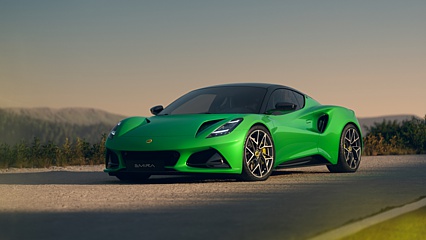

Emira V6 SE
The new Emira V6 SE builds on the pure driving pleasure Lotus is known for. The beloved six-cylinder powertrain of the Emira remains unchanged: a supercharged 3.5-litre V6 engine with 400 hp, mated to a six-speed manual gearbox with LSD (Limited Slip Differential) as standard or an optional automatic transmission, allowing for a 0-62 mph (0-100 kph) sprint in 4.3 seconds. The iconic V6 powertrain has been refined for even more emotional engagement, including the introduction of a new compression mount for the manual gearbox, resulting in more precise gear changes.
Also, optimised damper calibration and subtle adjustments in wheel alignment provide sharper handling and increased ride comfort. The car has two defined chassis and suspension settings. Tour is tuned for everyday road use, delivering the optimum blend of Lotus dynamic performance and handling with a more comfortable ride. Sports provides a slightly stiffer suspension set-up for enhanced dynamic capability and feel. Hydraulic steering provides excellent feedback for the driver.
The Emira V6 SE is finished in Zinc Grey as standard and sets itself apart with exclusive features such as specific V6 SE badges, the extended Black Pack, 20-inch forged alloy wheels, red brake callipers and a luxurious interior finished with alcantara and sport pedals. The Emira V6 SE stands out with a high degree of personalisation, featuring 15 exterior colours and seven interior themes. This is complemented by a choice of four brake calliper finishes and eight wheel designs, allowing for a uniquely tailored expression of the car’s character. Prices for the Emira V6 SE start at £96.500* in UK (Germany: €117.500*).
The new Emira V6 SE builds on the pure driving pleasure Lotus is known for. The beloved six-cylinder powertrain of the Emira remains unchanged: a supercharged 3.5-litre V6 engine with 400 hp, mated to a six-speed manual gearbox with LSD (Limited Slip Differential) as standard or an optional automatic transmission, allowing for a 0-62 mph (0-100 kph) sprint in 4.3 seconds. The iconic V6 powertrain has been refined for even more emotional engagement, including the introduction of a new compression mount for the manual gearbox, resulting in more precise gear changes.
Also, optimised damper calibration and subtle adjustments in wheel alignment provide sharper handling and increased ride comfort. The car has two defined chassis and suspension settings. Tour is tuned for everyday road use, delivering the optimum blend of Lotus dynamic performance and handling with a more comfortable ride. Sports provides a slightly stiffer suspension set-up for enhanced dynamic capability and feel. Hydraulic steering provides excellent feedback for the driver.
The Emira V6 SE is finished in Zinc Grey as standard and sets itself apart with exclusive features such as specific V6 SE badges, the extended Black Pack, 20-inch forged alloy wheels, red brake callipers and a luxurious interior finished with alcantara and sport pedals. The Emira V6 SE stands out with a high degree of personalisation, featuring 15 exterior colours and seven interior themes. This is complemented by a choice of four brake calliper finishes and eight wheel designs, allowing for a uniquely tailored expression of the car’s character. Prices for the Emira V6 SE start at £96.500* in UK (Germany: €117.500*).
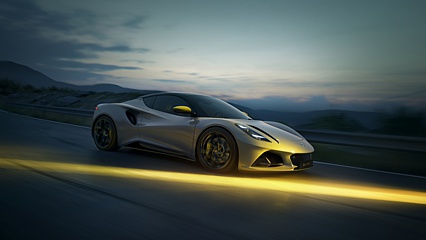

Better than ever
Simultaneously with the introduction of the V6 SE, Lotus provides the existing Emira models with a series of technical enhancements that improve both track performance and daily driving comfort. The cooling system has been optimised by routing the coolant lines differently, providing better flow to both the transmission oil cooler and the main cooling radiator. This results in more cooling and lower vehicle weight. In addition, the air-conditioning control system has been recalibrated to provide a more stable interior climate at high temperatures, and the opening temperature of the engine thermostat has been increased from 65°C to 75°C, improving heating and performance under severe conditions. Finally, the Dual Clutch Transmission (DCT) has been recalibrated, resulting in faster shift times, improved shift quality and smoother interaction between transmission and driver.
In terms of safety, the Lotus Emira is equipped with advanced driver assistance systems (ADAS) as standard. On top of that, there is the option of an Extended Co-Driver Pack for extra support. Standard features on the model include Autonomous Emergency Braking (AEB), Lane Departure Warning, Blind Spot Warning, Traffic Sign Recognition (TSR) and Fatigue Detection. The optional Extended Co-Driver Pack adds Adaptive Cruise Control (only compatible with automatic transmission), Rear Cross Traffic Alert, Door Opening Warning and High Beam Assist. All these systems are designed to enhance safety without compromising the sheer driving pleasure that characterises the Emira. A user-friendly menu allows the driver to set the desired level of assistance entirely according to his or her preferences.
Simultaneously with the introduction of the V6 SE, Lotus provides the existing Emira models with a series of technical enhancements that improve both track performance and daily driving comfort. The cooling system has been optimised by routing the coolant lines differently, providing better flow to both the transmission oil cooler and the main cooling radiator. This results in more cooling and lower vehicle weight. In addition, the air-conditioning control system has been recalibrated to provide a more stable interior climate at high temperatures, and the opening temperature of the engine thermostat has been increased from 65°C to 75°C, improving heating and performance under severe conditions. Finally, the Dual Clutch Transmission (DCT) has been recalibrated, resulting in faster shift times, improved shift quality and smoother interaction between transmission and driver.
In terms of safety, the Lotus Emira is equipped with advanced driver assistance systems (ADAS) as standard. On top of that, there is the option of an Extended Co-Driver Pack for extra support. Standard features on the model include Autonomous Emergency Braking (AEB), Lane Departure Warning, Blind Spot Warning, Traffic Sign Recognition (TSR) and Fatigue Detection. The optional Extended Co-Driver Pack adds Adaptive Cruise Control (only compatible with automatic transmission), Rear Cross Traffic Alert, Door Opening Warning and High Beam Assist. All these systems are designed to enhance safety without compromising the sheer driving pleasure that characterises the Emira. A user-friendly menu allows the driver to set the desired level of assistance entirely according to his or her preferences.
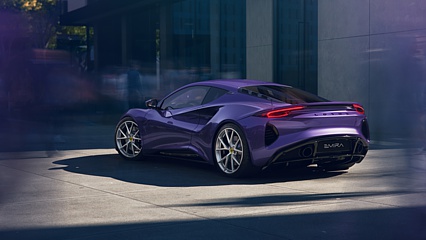

Emira Turbo
The Emira Turbo marks the entry point to the Emira lineup, designed for everyday usability while preserving the unmistakable Lotus driving thrill. It is powered by the same 4-cylinder twin-scroll turbo engine and 8-speed DCT gearbox as found in the Turbo SE, both sourced from technology partner AMG and achieves a 0-62 mph (0-100 kph) sprint in 4.4 seconds. The Emira Turbo features both Tour- and Sport driving modes, and high-performance components such as double wishbones, an integrated rear spoiler and electro-hydraulic power steering.
As standard, the Emira Turbo is richly equipped with modern safety technologies such as Autonomous Emergency Braking, Traffic Sign Recognition, Blind Spot Warning and Fatigue Detection. In addition, driver comfort is provided by 12-way electrically adjustable seats with memory, a 190W audio system, and wireless connectivity for Apple CarPlay and Android Auto. Optionally, customers can choose packages such as the Convenience Pack, Extended Co-Driver Pack and Extended Lower Black Pack, which further enhance both functionality and appearance. Externally, the Emira Turbo stands out with Turbo badges, yellow-black Lotus emblems and satin silver details. The Emira Turbo is available to order from £79.500* (Germany from €97.500*)
The Emira Turbo marks the entry point to the Emira lineup, designed for everyday usability while preserving the unmistakable Lotus driving thrill. It is powered by the same 4-cylinder twin-scroll turbo engine and 8-speed DCT gearbox as found in the Turbo SE, both sourced from technology partner AMG and achieves a 0-62 mph (0-100 kph) sprint in 4.4 seconds. The Emira Turbo features both Tour- and Sport driving modes, and high-performance components such as double wishbones, an integrated rear spoiler and electro-hydraulic power steering.
As standard, the Emira Turbo is richly equipped with modern safety technologies such as Autonomous Emergency Braking, Traffic Sign Recognition, Blind Spot Warning and Fatigue Detection. In addition, driver comfort is provided by 12-way electrically adjustable seats with memory, a 190W audio system, and wireless connectivity for Apple CarPlay and Android Auto. Optionally, customers can choose packages such as the Convenience Pack, Extended Co-Driver Pack and Extended Lower Black Pack, which further enhance both functionality and appearance. Externally, the Emira Turbo stands out with Turbo badges, yellow-black Lotus emblems and satin silver details. The Emira Turbo is available to order from £79.500* (Germany from €97.500*)
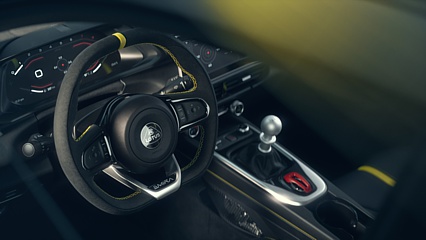

Racing Line
Finally, Lotus launches the Racing Line. For enthusiasts who want to give their Emira an extra sporty look, Lotus introduces the Racing Line design option, available on the Turbo SE and V6 SE. Racing Line adds a subtle, lower pinstripe in yellow, red or silver, perfectly matched to the colour of the brake callipers - the mirror caps get the same accent colour. Racing Line badges with a matching accent, high-gloss black wheels and a black and silver exterior logo complete the dynamic look. Inside, it is further enhanced by a special interior badge and stitching in the chosen accent colour, creating a perfect match.
Hand-built at the historic Lotus facility in Hethel, where the brand has produced sports cars since 1966, the Emira benefits from state-of-the-art production methods that enhance both quality and efficiency. It’s the perfect expression of Lotus’ ‘For The Drivers’-mentality - where heritage meets innovation.
Finally, Lotus launches the Racing Line. For enthusiasts who want to give their Emira an extra sporty look, Lotus introduces the Racing Line design option, available on the Turbo SE and V6 SE. Racing Line adds a subtle, lower pinstripe in yellow, red or silver, perfectly matched to the colour of the brake callipers - the mirror caps get the same accent colour. Racing Line badges with a matching accent, high-gloss black wheels and a black and silver exterior logo complete the dynamic look. Inside, it is further enhanced by a special interior badge and stitching in the chosen accent colour, creating a perfect match.
Hand-built at the historic Lotus facility in Hethel, where the brand has produced sports cars since 1966, the Emira benefits from state-of-the-art production methods that enhance both quality and efficiency. It’s the perfect expression of Lotus’ ‘For The Drivers’-mentality - where heritage meets innovation.
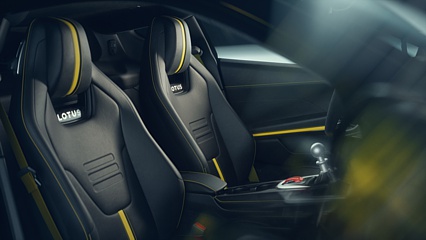

Lotus Emira V6 SE technical specifications
Lotus Emira Turbo and Turbo SE technical specifications
* Pricing and specifications correct at time of publication and subject to change without notice. Final pricing may vary depending on market, options selected, local taxes and currency fluctuations. Terms and conditions apply. Please contact your local Lotus retailer for the most up-to-date information.
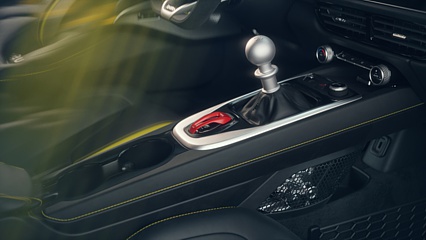
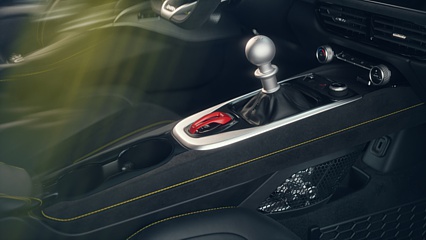
The Lotus Emira is available for configuration at lotuscars.com.
| Engine configuration | 3,456cc supercharged V6 |
| Transmission | 6-speed manual/automatic |
| Max power (bhp/kW) | 400bhp/298kW |
| Top speed (mph/km/h) | 180/290 |
| 0-62mph/0-100km/h (secs) | 4.3 |
| Front brake disc diameter (mm) | 370mm x 32mm |
| Rear brake disc diameter (mm) | 350mm x 32mm |
| Callipers | AP Racing 4-piston with braided hoses |
Lotus Emira Turbo and Turbo SE technical specifications
| Engine configuration | 1,991cc turbocharged four-cylinder in-line petrol four valves per cylinder; variable valve timing single twin-scroll turbocharger 200bar piezo direct fuel injection + port fuel injection |
| Transmission | Eight-speed dual-clutch |
| Max power (bhp/kW) | 360/269 (Turbo SE: 400/294) |
| Top speed (mph/km/h) | 171/275 (Turbo SE: 181/291) |
| 0-62mph/0-100km/h (secs) | 4.4 (Turbo SE: 4.0) |
| Front brake disc diameter (mm) | 370mm x 32mm |
| Rear brake disc diameter (mm) | 350mm x 32mm |
| Callipers | AP Racing 4-piston with braided hoses |
* Pricing and specifications correct at time of publication and subject to change without notice. Final pricing may vary depending on market, options selected, local taxes and currency fluctuations. Terms and conditions apply. Please contact your local Lotus retailer for the most up-to-date information.


The Lotus Emira is available for configuration at lotuscars.com.
Quelle: Lotus Cars
30.05.2025
... Sustainability And Innovation.
Lotus Technology Inc. (“Lotus Tech” or the “Company”) (Nasdaq: LOT), a leading global intelligent and luxury mobility provider, today released its 2024 Environmental, Social, and Governance (ESG) Report, highlighting the Company’s progress in advancing sustainable practices, innovative green products, and global leadership in clean mobility. The report has been audited by TÜV NORD, an independent third-party inspection, testing and assurance agency.
“Lotus Tech’s 2024 ESG report reflects our unwavering commitment to driving sustainable change and creating a better future for all,” said Dr. Daxue Wang, Chairman of the ESG Committee at Lotus Tech. “Through cutting-edge innovation, responsible manufacturing, and active participation in global sustainability efforts, we are dedicated to delivering eco-friendly solutions and fostering a more sustainable world.”
“Lotus Tech’s 2024 ESG report reflects our unwavering commitment to driving sustainable change and creating a better future for all,” said Dr. Daxue Wang, Chairman of the ESG Committee at Lotus Tech. “Through cutting-edge innovation, responsible manufacturing, and active participation in global sustainability efforts, we are dedicated to delivering eco-friendly solutions and fostering a more sustainable world.”

Key Highlights from the 2024 ESG Report:
To read Lotus Tech’s 2024 ESG Report, please visit www.group-lotus.com/esg.
- Innovative Green Products: Lotus Tech unveiled its first concept car, Theory 1, centered on advanced technology, material minimization, and sustainable development. In contrast to mainstream industry models that utilize on average 100 A-surface materials, Theory 1 sets a "Challenge of 10" goal, employing only ten main A-surface materials, with performance, lightweight and sustainable properties.
- Green Manufacturing Excellence: Lotus Global Smart Factory has been awarded the prestigious “Leading-Zero Carbon Factory” certification, recognizing its efforts to achieve carbon neutrality and sustainable production practices.
- Global Sustainability Engagement: Lotus Tech actively participated in the global sustainability initiatives and reporting. In 2024, Lotus Tech has contributed show cases for the World Economic Forum (WEF)’s Nature Positive Transitions Report series, demonstrating its commitment to driving global climate action.
To read Lotus Tech’s 2024 ESG Report, please visit www.group-lotus.com/esg.
Quelle: Lotus Cars
03.05.2025
- Limited edition of 60 cars available in selected markets
- Special collaboration with the Jim Clark Trust, celebrating 60 years since the greatest season of successes by any racing driver
- World premiere at the 2025 Formula 1 Miami Grand Prix
- Based on the Emira V6, with a 400 hp supercharged 3.5-litre V6 engine
- Design inspired by the legendary Team Lotus cars that won the F1 World Championship and Indianapolis 500 in 1965
- Bespoke Clark Racing Green exterior paint and heritage-inspired livery
- Unique Jim Clark badging and interior details
- Special collaboration with the Jim Clark Trust, celebrating 60 years since the greatest season of successes by any racing driver
- World premiere at the 2025 Formula 1 Miami Grand Prix
- Based on the Emira V6, with a 400 hp supercharged 3.5-litre V6 engine
- Design inspired by the legendary Team Lotus cars that won the F1 World Championship and Indianapolis 500 in 1965
- Bespoke Clark Racing Green exterior paint and heritage-inspired livery
- Unique Jim Clark badging and interior details
Lotus honours one of the greatest drivers of all time with the introduction of the Emira Clark Edition, in collaboration with the Jim Clark Trust. This exclusive model, limited to just 60 cars for selected markets, will make its world debut leading at the Formula 1 Miami Grand Prix.
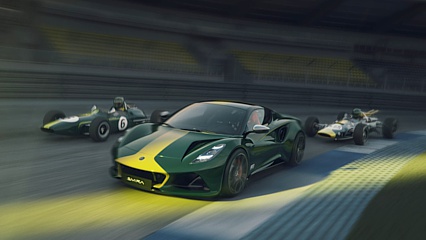
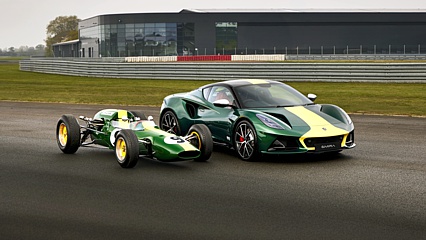
The legacy of Jim Clark and Team Lotus is forever etched into the history of motorsport. In 1965, Clark secured the Formula 1 World Championship with Team Lotus and triumphed in the iconic Indianapolis 500 — a remarkable double victory that remains unmatched to this day. That same year, Clark further demonstrated his extraordinary talent with championship victories in Formula 2 and the Tasman Series in Australia and New Zealand, as well as winning touring car races in a Lotus Cortina.
This unparalleled success story serves as the inspiration behind the creation of the Lotus Emira Clark Edition — a fitting tribute to a driver whose achievements continue to define excellence and innovation in racing.
This unparalleled success story serves as the inspiration behind the creation of the Lotus Emira Clark Edition — a fitting tribute to a driver whose achievements continue to define excellence and innovation in racing.
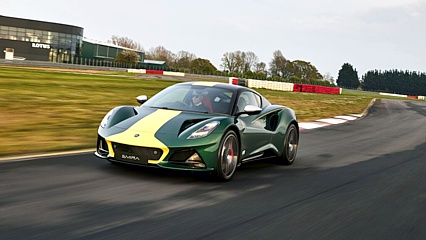

Exclusive design and interior
The body of the exclusive Emira is finished in Clark Racing Green with a contrasting black roof, silver mirrors and an iconic yellow racing stripe flared around the front end, inspired by Clark’s 1965 Indianapolis 500-winning Lotus Type 38. A machined aluminium fuel filler cap with a blue anodised centre and yellow exhaust pipes further enhance the exclusive look. A hand-painted yellow pinstripe picks out the Emira swage line, complemented by Clark Edition branding on the doors inspired by the Clark logo used on his racing cars.
The body of the exclusive Emira is finished in Clark Racing Green with a contrasting black roof, silver mirrors and an iconic yellow racing stripe flared around the front end, inspired by Clark’s 1965 Indianapolis 500-winning Lotus Type 38. A machined aluminium fuel filler cap with a blue anodised centre and yellow exhaust pipes further enhance the exclusive look. A hand-painted yellow pinstripe picks out the Emira swage line, complemented by Clark Edition branding on the doors inspired by the Clark logo used on his racing cars.
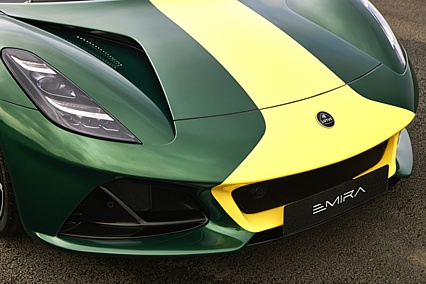
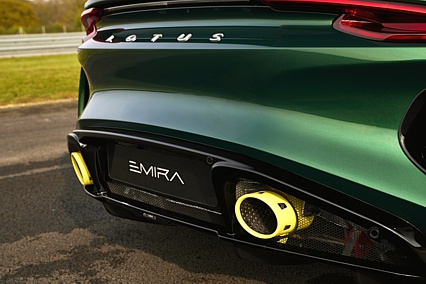
The interior exudes pure motorsport and nostalgia. The sports seats’ asymmetrical finish is reminiscent of the red-trimmed Lotus racing cars Clark drove in 1965 and emphasise the driver-focused nature of the Emira Clark Edition with a driver's seat upholstered in red leather and Alcantara®, while the passenger seat is upholstered in black leather and Alcantara®.
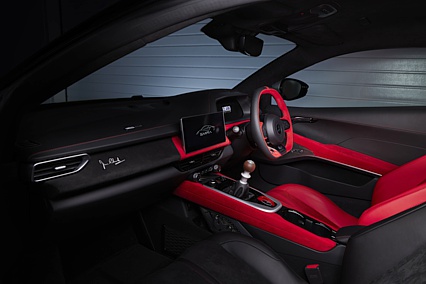
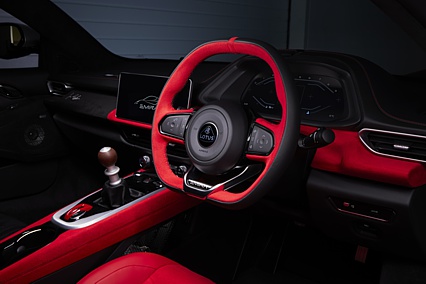
The Emira Clark Edition also has a sixties-style wooden gear knob and special commemorative Jim Clark badging featuring Clark’s personalised tartan from Lochcarron, Scotland. Additional details complement the interior, including a Jim Clark signature on the dashboard and Team Lotus detailing on the seats.
Every Emira Clark Edition will have numbered carbon fibre treadplates (1 of 60) adding to the exclusive feel of this very limited edition. Each customer will also receive a bespoke hand-crafted leather holdall with unique Clark Edition details.
Every Emira Clark Edition will have numbered carbon fibre treadplates (1 of 60) adding to the exclusive feel of this very limited edition. Each customer will also receive a bespoke hand-crafted leather holdall with unique Clark Edition details.
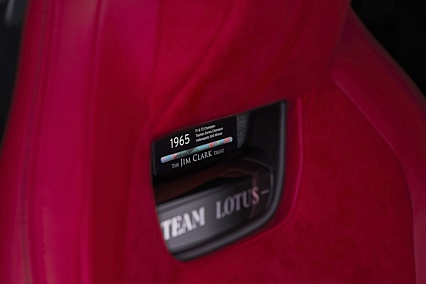

Based on the powerful Lotus Emira V6
The Emira Clark Edition is based on the Lotus Emira V6 and combines the brand’s sporting performance with a stylish tribute to the Scottish racing legend and his Lotus racing cars. The Lotus Emira V6 is powered by a 400 hp supercharged 3.5-litre V6 engine with a six-speed manual gearbox and limited-slip differential. The Emira V6 offers a pure driving experience thanks to the unfiltered hydraulic steering feel and the Lotus Driver’s pack which includes sports suspension, Track Mode and revised exhaust sound.
The Emira Clark Edition is based on the Lotus Emira V6 and combines the brand’s sporting performance with a stylish tribute to the Scottish racing legend and his Lotus racing cars. The Lotus Emira V6 is powered by a 400 hp supercharged 3.5-litre V6 engine with a six-speed manual gearbox and limited-slip differential. The Emira V6 offers a pure driving experience thanks to the unfiltered hydraulic steering feel and the Lotus Driver’s pack which includes sports suspension, Track Mode and revised exhaust sound.
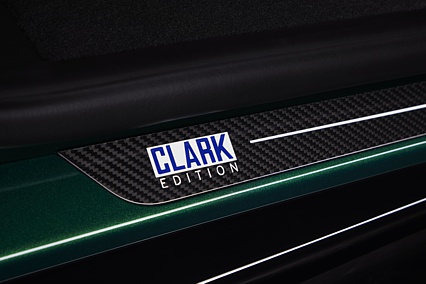
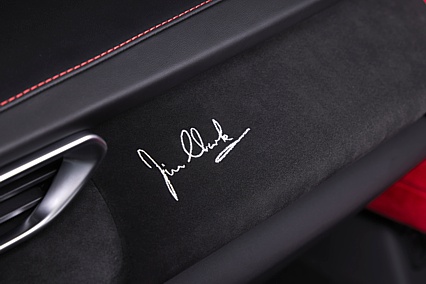
A worldwide tribute to a racing legend
With the Emira Clark Edition, Lotus pays tribute to one of the most iconic drivers in the history of motorsport. The combination of exclusive design and uncompromising performance makes this limited edition a coveted collector's item for car enthusiasts worldwide.
The Emira Clark Edition pricing will be £115,000 in the UK (€140,000 in Germany).
With the Emira Clark Edition, Lotus pays tribute to one of the most iconic drivers in the history of motorsport. The combination of exclusive design and uncompromising performance makes this limited edition a coveted collector's item for car enthusiasts worldwide.
The Emira Clark Edition pricing will be £115,000 in the UK (€140,000 in Germany).
Quelle: Lotus Cars
25.04.2025
... Spirit And Racing Soul.
Lotus today reveals its latest global brand campaign with the launch of a new film titled “Are You a Driver or What?” - a bold statement of intent that reflects the brand’s unapologetic spirit, engineering precision and legendary racing heritage.
More than just a film, Are You a Driver or What? Is a celebration of what it means to be truly connected to a brand that has been making and breaking the rules for 75 years.
Fans and brand advocates are encouraged to share the film across their own platforms using #AreYouADriverOrWhat and tagging @lotuscars.
Fans and brand advocates are encouraged to share the film across their own platforms using #AreYouADriverOrWhat and tagging @lotuscars.
Quelle: Lotus Cars
17.04.2025
... Integrate All Business Under Lotus Brand.
Lotus Technology Inc. (“Lotus Tech” or the “Company”) (Nasdaq: LOT), a leading global intelligent and luxury mobility provider, today announced that Geely International (Hong Kong) Limited (“Geely”) exercised its put option on April 14, 2025, requiring us to purchase 51% of the equity interests in Lotus Advance Technologies Sdn Bhd (“Lotus UK”) held by Geely pursuant to the Put Option Agreement dated January 31, 2023 between the parties.
Lotus UK controls the manufacturing operations for Lotus’ sportscars and hyper cars, and Lotus Engineering which provides comprehensive consultancy services to many of the OEMs and Tier 1 suppliers around the world.
Pursuant to the exercise of put option from Geely, the Company expects to acquire 51% of the equity interest in Lotus UK through a non-cash transaction based on a pre-agreed pricing method. Upon completion, the Company will gain control over Lotus UK and consolidate its financial results. The strategic transaction will enable the Company to integrate all businesses under Lotus brand.
Lotus UK controls the manufacturing operations for Lotus’ sportscars and hyper cars, and Lotus Engineering which provides comprehensive consultancy services to many of the OEMs and Tier 1 suppliers around the world.
Pursuant to the exercise of put option from Geely, the Company expects to acquire 51% of the equity interest in Lotus UK through a non-cash transaction based on a pre-agreed pricing method. Upon completion, the Company will gain control over Lotus UK and consolidate its financial results. The strategic transaction will enable the Company to integrate all businesses under Lotus brand.

The acquisition is expected to be completed in 2025, subject to potential regulatory approvals.
In conjunction with the business combination between the Company and L Catterton Asia Acquisition Corp, a special purpose acquisition company affiliated with L Catterton, a leading global consumer-focused investment firm, the Company and Lotus UK entered into a Put Option Agreement with each of Geely and Etika. Pursuant to these agreements, each of Geely and Etika was granted the right to require the Company to acquire its equity interest in Lotus UK at a pre-agreed pricing method* and upon satisfaction of the condition (“Put Option Exercise Condition”) that the total number of vehicles sold by Lotus UK and its subsidiaries shall exceed 5,000 in 2024, with the exercise of such options by Geely and Etika not cross-conditioned on one another. As of December 31, 2024, the Put Option Exercise Condition had been satisfied.
Mr. Qingfeng Feng, Chief Executive Officers, said: "This acquisition marks a critical milestone in our strategic journey to fully integrate all businesses under the Lotus brand, which will strengthen brand equity and enhance our operational flexibility and internal synergies. We are confident that the transaction will create substantial long-term value for our shareholders.”
In conjunction with the business combination between the Company and L Catterton Asia Acquisition Corp, a special purpose acquisition company affiliated with L Catterton, a leading global consumer-focused investment firm, the Company and Lotus UK entered into a Put Option Agreement with each of Geely and Etika. Pursuant to these agreements, each of Geely and Etika was granted the right to require the Company to acquire its equity interest in Lotus UK at a pre-agreed pricing method* and upon satisfaction of the condition (“Put Option Exercise Condition”) that the total number of vehicles sold by Lotus UK and its subsidiaries shall exceed 5,000 in 2024, with the exercise of such options by Geely and Etika not cross-conditioned on one another. As of December 31, 2024, the Put Option Exercise Condition had been satisfied.
Mr. Qingfeng Feng, Chief Executive Officers, said: "This acquisition marks a critical milestone in our strategic journey to fully integrate all businesses under the Lotus brand, which will strengthen brand equity and enhance our operational flexibility and internal synergies. We are confident that the transaction will create substantial long-term value for our shareholders.”
Quelle: Lotus Cars
10.04.2025
... Victory At Estoril.
- The Lotus 97T returns to Estoril, exactly 40 years after Ayrton Senna's first Formula 1 victory
- Ayrton's nephew, Bruno Senna, will drive the car in tribute of this historic moment
- The Lotus 97T was a pioneering race car, featuring innovations such as early bargeboards, which remain a staple of modern F1
aerodynamics
- This will be a celebration of the turbocharged era of racing, showcasing the lasting impact of Lotus innovations in Formula 1
history
- Ayrton's nephew, Bruno Senna, will drive the car in tribute of this historic moment
- The Lotus 97T was a pioneering race car, featuring innovations such as early bargeboards, which remain a staple of modern F1
aerodynamics
- This will be a celebration of the turbocharged era of racing, showcasing the lasting impact of Lotus innovations in Formula 1
history
April 21 marks a historic milestone in the Lotus and Formula 1 history books - the 40th anniversary of Ayrton Senna’s first Grand Prix victory. To honour this iconic moment, the same Lotus 97T Formula 1 car that Senna drove to his legendary win at the 1985 Portuguese Grand Prix, will return to the Estoril circuit for the first time since that triumph. Driving the car will be his nephew, Bruno Senna, commemorating one of F1’s most defining performances.
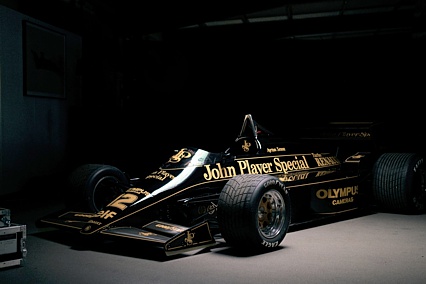
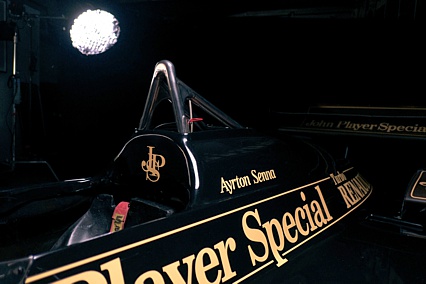
The event unites two major celebrations: the 75th anniversary of Formula 1 and the pivotal role Lotus played in shaping its legacy. It serves as a tribute not only to Ayrton Senna but also to the engineers, designers and all the drivers who propelled Lotus to racing greatness.
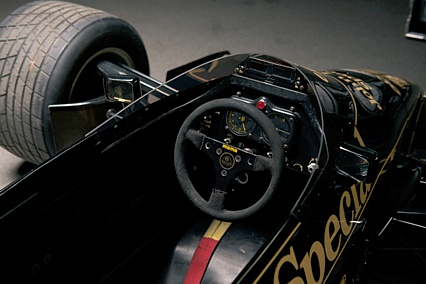

Ayrton Senna’s victory at Estoril was a masterclass in wet-weather driving, with the Brazilian lapping nearly the entire field to claim the first of his 41 Formula 1 wins. Senna also regarded this performance as the greatest of his career, and dismissed the widely held belief that his 1993 Donington win was his finest drive: Senna was quoted saying: “No way! I had traction control there. It was a good win but compared with Estoril ‘85 it was nothing.”


The Lotus 97T itself was a pioneering race car and was the first to feature vertical aerodynamic devices behind the front wheels for airflow management, which eventually developed into the highly sophisticated bargeboards, which remain in modern F1 aerodynamics.
The tribute event solidifies the connection between Lotus and Senna’s remarkable rise in Formula 1, celebrating the golden era of turbocharged racing and the spirit of innovation that defined both the driver and the team.
The tribute event solidifies the connection between Lotus and Senna’s remarkable rise in Formula 1, celebrating the golden era of turbocharged racing and the spirit of innovation that defined both the driver and the team.


Clive Chapman, Managing Director of Classic Team Lotus said: “For Team Lotus, Ayrton’s arrival was a defining moment. His talent, technical understanding and relentless drive helped push the team forward. This anniversary allows us to relive that magic and honour his legacy. Bruno Senna’s commemorative drive at Estoril promises to be an emotional and historic moment, bringing the past full circle and cementing Senna’s enduring impact on motorsport."


Bruno Senna commented “It will be an incredible feeling to drive this iconic car, marking the beginning of a series of victories and achievements by my uncle. This celebration will bring together fans from all over the world and shows how Ayrton Senna remains a powerful name in motorsport, and a positive influence on society in many ways - from educational impact to sustainable innovation, and as a movement that continues to inspire generations to persue their dream and never give up."
Before heading to Estoril, the Lotus 97T will also be running at the 82nd Goodwood Members' Meeting on the 12th and 13th April, acting as a fitting send-off before its homecoming lap in Portugal.
Before heading to Estoril, the Lotus 97T will also be running at the 82nd Goodwood Members' Meeting on the 12th and 13th April, acting as a fitting send-off before its homecoming lap in Portugal.


Bruno Senna commented “It will be an incredible feeling to drive this iconic car, marking the beginning of a series of victories and achievements by my uncle. This celebration will bring together fans from all over the world and shows how Ayrton Senna remains a powerful name in motorsport, and a positive influence on society in many ways - from educational impact to sustainable innovation, and as a movement that continues to inspire generations to persue their dream and never give up."
Before heading to Estoril, the Lotus 97T will also be running at the 82nd Goodwood Members' Meeting on the 12th and 13th April, acting as a fitting send-off before its homecoming lap in Portugal.
Before heading to Estoril, the Lotus 97T will also be running at the 82nd Goodwood Members' Meeting on the 12th and 13th April, acting as a fitting send-off before its homecoming lap in Portugal.


Ahead of the 82nd Members’ Meeting, The Duke of Richmond CBE DL, said: "Goodwood has always celebrated motorsport’s greatest icons, and it's an honour to host the Lotus 97T ahead of its return to Estoril. Seeing the legendary car on track once again will be a fitting tribute to Ayrton Senna's legacy and a special moment for fans, who can see the car in action again at the Festival of Speed in July."
Lotus will be sharing all stories, interviews and reactions across social media, and the historic lap will be filmed and shared by various media outlets, including Sky Sports F1.
Lotus will be sharing all stories, interviews and reactions across social media, and the historic lap will be filmed and shared by various media outlets, including Sky Sports F1.
Quelle: Lotus Cars
03.04.2025
- New ‘600’ and ‘900’ model naming reflects electrifying power output
- Historic GT, GT SE and Sport trim level names return
- Revised line-up offers customers convenient choice in luxury and tech or pronounced sportiness
- New model range, impressive performance, ground-breaking charging performance
- Available to order now, debuts this summer at Lotus retailers
- Competitive pricing: Eletre 600 starts at £84.990 (€ 99.990) and Emeya 600 starts at £84.990 (EU markets from € 107.990 for
Emeya 600 GT)
- Historic GT, GT SE and Sport trim level names return
- Revised line-up offers customers convenient choice in luxury and tech or pronounced sportiness
- New model range, impressive performance, ground-breaking charging performance
- Available to order now, debuts this summer at Lotus retailers
- Competitive pricing: Eletre 600 starts at £84.990 (€ 99.990) and Emeya 600 starts at £84.990 (EU markets from € 107.990 for
Emeya 600 GT)
With the arrival of the new model year, Lotus has revamped the line-up for its Eletre hyper-SUV and Emeya hyper-GT. Thanks to a revised model range, Lotus now offers customers more convenience, clarity and tailored customisation in configuring their perfect Eletre or Emeya. Key novelty is the ‘600’ and ‘900’ model names, that clearly reflects the electrifying power output of the new models. At the same time, legendary equipment level references like GT and GT SE from Lotus' rich heritage return to the present.
New line-up
Effective immediately, Lotus offers the Eletre hyper-SUV and Emeya hyper-GT as '600' or '900', a reference to the two power output versions of both models. Subsequently Lotus pairs those new versions with clearly identifiable, predefined equipment levels containining popular options and choices. Meaning customers can now express a specific preference for pronounced sportiness or rather a more luxurious and technology led specification.
Recently, the Lotus Emira sports car preceded the Eletre and Emeya by referencing trim level from the legendary past back into the current range, introducing the Emira Turbo SE. Lotus now continues that strategy with the completely new line-up for the Eletre and Emeya, giving legendary naming’s like GT and GT SE a modern new appearance.
As a result, the Lotus Eletre is now available in six clearly defined trim levels: Eletre 600, 600 GT, 600 GT SE and 600 SPORT SE, as well as 900 SPORT and the Eletre 900 SPORT CARBON as the absolute flagship. The Lotus Emeya follows the same nomenclature (Emeya 600 not available in Europe). Complementing these well-defined trim levels, customers can subsequently further customise their car to their own personal taste thanks to a wide selection of optional packages, individual options and colours. New colours in the pallet are Zenith White and Akoya White for the Eletre, while interior-wise customers can now also opt for the Quartz and Jasper interior themes with the new LOTUSWEAR Performance Fabric for the seats.
New line-up
Effective immediately, Lotus offers the Eletre hyper-SUV and Emeya hyper-GT as '600' or '900', a reference to the two power output versions of both models. Subsequently Lotus pairs those new versions with clearly identifiable, predefined equipment levels containining popular options and choices. Meaning customers can now express a specific preference for pronounced sportiness or rather a more luxurious and technology led specification.
Recently, the Lotus Emira sports car preceded the Eletre and Emeya by referencing trim level from the legendary past back into the current range, introducing the Emira Turbo SE. Lotus now continues that strategy with the completely new line-up for the Eletre and Emeya, giving legendary naming’s like GT and GT SE a modern new appearance.
As a result, the Lotus Eletre is now available in six clearly defined trim levels: Eletre 600, 600 GT, 600 GT SE and 600 SPORT SE, as well as 900 SPORT and the Eletre 900 SPORT CARBON as the absolute flagship. The Lotus Emeya follows the same nomenclature (Emeya 600 not available in Europe). Complementing these well-defined trim levels, customers can subsequently further customise their car to their own personal taste thanks to a wide selection of optional packages, individual options and colours. New colours in the pallet are Zenith White and Akoya White for the Eletre, while interior-wise customers can now also opt for the Quartz and Jasper interior themes with the new LOTUSWEAR Performance Fabric for the seats.


Overview of main standard features per model
As a result, the newly defined model line-up for the Lotus Eletre and Emeya now offers more convenience and tailored customisation with specific highlights for each trim level:
- Eletre 600: 450 kW (612 bhp) dual-motor, 4WD, 112 kWh battery pack, 22kW onboard charger, active air suspension with Continuous Damping Control, 20-inch wheels, torque vectoring by brake, LED matrix headlights, KEF PREMIUM 15 speaker audio, 29" HUD, 4 zone climate control, Jasper interior theme with LOTUSWEAR Performance Fabric for the seats
- Eletre 600 GT: Highway assist, parking pack, 22" alloy wheels, 6 piston brakes
- Eletre 600 GT SE: Intelligent glass roof, KEF REFERENCE 23 speakers audio, configurable ambient lighting, illuminated side sills
- Eletre 600 SPORT SE: Lotus dynamic handling pack, active rear spoiler, massaging & ventilated front seats, soft-close doors
- Eletre 900 SPORT: 675 kW dual-motor, 2-speed transmission, Lotus dynamic handling pack, active rear spoiler, Quartz interior theme with LOTUSWEAR Performance Fabric for the seats
- Eletre 900 SPORT CARBON: extended exterior carbon pack, interior carbon pack, Sports bonnet (lightweight composite material), massaging & ventilated front seats, soft-close doors
- Emeya 600 (UK only): 450 kW (612 bhp) dual-motor, 4WD, 102 kWh battery pack, 22kW onboard charger, active air suspension with Continuous Damping Control, 20-inch wheels, torque vectoring by brake, LED matrix headlights, KEF PREMIUM 15 speaker audio, 51" HUD, 4 zone climate control, Jasper interior theme with LOTUSWEAR Performance Fabric for the seats
- Emeya 600 GT: Highway assist, parking pack, 21" alloy wheels, 6 piston brakes
- Emeya 600 GT SE: Intelligent glass roof, hands-free tailgate, configurable ambient lighting, illuminated side sills
- Emeya 600 SPORT SE: Lotus dynamic handling pack, active rear spoiler, active rear diffuser and active front air dam, massaging & ventilated front seats, soft-close doors
- Emeya 900 SPORT: 675 kW (918 hp) dual-motor, 2-speed transmission, Lotus dynamic handling pack, active rear spoiler, Quartz interior theme with LOTUSWEAR Performance Fabric for the seats
- Emeya 900 SPORT CARBON: extended exterior carbon pack, extended interior carbon pack, active rear diffuser, active front air dam, massaging & ventilated front seats, soft-close doors
As a result, the newly defined model line-up for the Lotus Eletre and Emeya now offers more convenience and tailored customisation with specific highlights for each trim level:
- Eletre 600: 450 kW (612 bhp) dual-motor, 4WD, 112 kWh battery pack, 22kW onboard charger, active air suspension with Continuous Damping Control, 20-inch wheels, torque vectoring by brake, LED matrix headlights, KEF PREMIUM 15 speaker audio, 29" HUD, 4 zone climate control, Jasper interior theme with LOTUSWEAR Performance Fabric for the seats
- Eletre 600 GT: Highway assist, parking pack, 22" alloy wheels, 6 piston brakes
- Eletre 600 GT SE: Intelligent glass roof, KEF REFERENCE 23 speakers audio, configurable ambient lighting, illuminated side sills
- Eletre 600 SPORT SE: Lotus dynamic handling pack, active rear spoiler, massaging & ventilated front seats, soft-close doors
- Eletre 900 SPORT: 675 kW dual-motor, 2-speed transmission, Lotus dynamic handling pack, active rear spoiler, Quartz interior theme with LOTUSWEAR Performance Fabric for the seats
- Eletre 900 SPORT CARBON: extended exterior carbon pack, interior carbon pack, Sports bonnet (lightweight composite material), massaging & ventilated front seats, soft-close doors
- Emeya 600 (UK only): 450 kW (612 bhp) dual-motor, 4WD, 102 kWh battery pack, 22kW onboard charger, active air suspension with Continuous Damping Control, 20-inch wheels, torque vectoring by brake, LED matrix headlights, KEF PREMIUM 15 speaker audio, 51" HUD, 4 zone climate control, Jasper interior theme with LOTUSWEAR Performance Fabric for the seats
- Emeya 600 GT: Highway assist, parking pack, 21" alloy wheels, 6 piston brakes
- Emeya 600 GT SE: Intelligent glass roof, hands-free tailgate, configurable ambient lighting, illuminated side sills
- Emeya 600 SPORT SE: Lotus dynamic handling pack, active rear spoiler, active rear diffuser and active front air dam, massaging & ventilated front seats, soft-close doors
- Emeya 900 SPORT: 675 kW (918 hp) dual-motor, 2-speed transmission, Lotus dynamic handling pack, active rear spoiler, Quartz interior theme with LOTUSWEAR Performance Fabric for the seats
- Emeya 900 SPORT CARBON: extended exterior carbon pack, extended interior carbon pack, active rear diffuser, active front air dam, massaging & ventilated front seats, soft-close doors


Unrivaled performance, For The Drivers
Although much has changed and has been improved for the new model year, the unrivalled performance of the Lotus Eletre and Emeya has remained untouched, resulting in the two models still being the benchmark in their respective segments. As a '600', both feature a 450 kW (612 hp) all-electric dual-motor powertrain and all-wheel drive as standard, a combination that guarantees stunning performance. The Emeya 600 accelerates from 0 to 62 mph (0 to 100 km/h) in just 4.15 seconds (Eletre 600: 4.5 seconds) and reaches a top speed of 155 mph (250 km/h). The Eletre 600 achieves a top speed of 159 mph (256 km/h), as just some striking examples.
Things can always go faster, and the new Eletre and Emeya '900' provide unmistakable evidence, representing superlatives in terms of performance. Both rely on a 675 kW (918 hp) strong dual-motor powertrain, providing the Emeya 900 with an acceleration from a standstill to 62 mph (100 km/h) in a stunning 2.78 seconds (Eletre 900: 2.95 sec) and a top speed of 155 mph (256 km/h). The maximum speed of the Eletre 900 is 159 mph (265 km/h).
No less impressive are their electrifying range and charging performances, which boost the Eletre and Emeya to the top performers in their respective segments. With a maximum WLTP range of 379 miles (610 km) for the Emeya, and 373 miles (600 km) for the Eletre, they are also ideally suited for long electric road trips. And when it is time for a charging stop, the Emeya, for example, also proves itself as an absolute top performer in this area. Thanks to its 800V battery technology with Advanced Lotus Hyper Charging it can be charged from 10-80% in around 14 minutes (under perfect conditions) using a 400kW DC charger (Eletre: 20 minutes from 10-80% at a 350kW DC charger), giving it the status of one of the fastest-charging EVs in the world.
Although much has changed and has been improved for the new model year, the unrivalled performance of the Lotus Eletre and Emeya has remained untouched, resulting in the two models still being the benchmark in their respective segments. As a '600', both feature a 450 kW (612 hp) all-electric dual-motor powertrain and all-wheel drive as standard, a combination that guarantees stunning performance. The Emeya 600 accelerates from 0 to 62 mph (0 to 100 km/h) in just 4.15 seconds (Eletre 600: 4.5 seconds) and reaches a top speed of 155 mph (250 km/h). The Eletre 600 achieves a top speed of 159 mph (256 km/h), as just some striking examples.
Things can always go faster, and the new Eletre and Emeya '900' provide unmistakable evidence, representing superlatives in terms of performance. Both rely on a 675 kW (918 hp) strong dual-motor powertrain, providing the Emeya 900 with an acceleration from a standstill to 62 mph (100 km/h) in a stunning 2.78 seconds (Eletre 900: 2.95 sec) and a top speed of 155 mph (256 km/h). The maximum speed of the Eletre 900 is 159 mph (265 km/h).
No less impressive are their electrifying range and charging performances, which boost the Eletre and Emeya to the top performers in their respective segments. With a maximum WLTP range of 379 miles (610 km) for the Emeya, and 373 miles (600 km) for the Eletre, they are also ideally suited for long electric road trips. And when it is time for a charging stop, the Emeya, for example, also proves itself as an absolute top performer in this area. Thanks to its 800V battery technology with Advanced Lotus Hyper Charging it can be charged from 10-80% in around 14 minutes (under perfect conditions) using a 400kW DC charger (Eletre: 20 minutes from 10-80% at a 350kW DC charger), giving it the status of one of the fastest-charging EVs in the world.


Eletre and Emeya: two of a kind
Like every Lotus, the Eletre- a pure electric performance SUV - and Emeya- a pure electric hyper-GT - are first and foremost cars ‘For The Drivers’. Their DNA is 100% Lotus, with exceptional, class-leading ride and handling, steering and aero performance. With their sleek design, powerful electric motors and luxurious interior, the Eletre and Emeya set new standards in the world of electric vehicles. The two share common characteristics like cutting-edge technology, a sophisticated design, exceptional performance and unparalleled driving experiences, whether you're seeking exhilarating speed, supreme comfort or advanced safety features. A signature element of the Eletre and Emeya designs is their ‘porosity’ – the aerodynamic principle of air flowing through the vehicle as well as under, over and around it. Porosity was at the heart of the Lotus Evija’s design, is integral to the Emira, and has provided clear inspiration for both the Eletre and Emeya.
High-quality interiors with luxury materials and tactile surfaces, a pristine fit and finish, customisable ambient lighting, an intelligent driver cockpit and intuitive infotainment systems create a premium and comfortable cabin environment, with features like ventilated seats with massage enhancing the overall immersive driving experience.
Available to order now, the Lotus Eletre and Emeya 600 and 900 will arrive at Lotus retailers this summer.
The newly defined trim levels have resulted in competitive pricing levels, with prices starting in UK/Europe at £84.990 - € 99.990 for the Eletre 600 and £84.990 for the Emeya 600 (EU markets from € 107.990 for Emeya 600 GT).
Detailed specification and pricing on the new Eletre and Emeya line-up is available at www.lotuscars.com.
Further information about the Lotus Eletre and Emeya can be found on the Lotus Media Site.
Like every Lotus, the Eletre- a pure electric performance SUV - and Emeya- a pure electric hyper-GT - are first and foremost cars ‘For The Drivers’. Their DNA is 100% Lotus, with exceptional, class-leading ride and handling, steering and aero performance. With their sleek design, powerful electric motors and luxurious interior, the Eletre and Emeya set new standards in the world of electric vehicles. The two share common characteristics like cutting-edge technology, a sophisticated design, exceptional performance and unparalleled driving experiences, whether you're seeking exhilarating speed, supreme comfort or advanced safety features. A signature element of the Eletre and Emeya designs is their ‘porosity’ – the aerodynamic principle of air flowing through the vehicle as well as under, over and around it. Porosity was at the heart of the Lotus Evija’s design, is integral to the Emira, and has provided clear inspiration for both the Eletre and Emeya.
High-quality interiors with luxury materials and tactile surfaces, a pristine fit and finish, customisable ambient lighting, an intelligent driver cockpit and intuitive infotainment systems create a premium and comfortable cabin environment, with features like ventilated seats with massage enhancing the overall immersive driving experience.
Available to order now, the Lotus Eletre and Emeya 600 and 900 will arrive at Lotus retailers this summer.
The newly defined trim levels have resulted in competitive pricing levels, with prices starting in UK/Europe at £84.990 - € 99.990 for the Eletre 600 and £84.990 for the Emeya 600 (EU markets from € 107.990 for Emeya 600 GT).
Detailed specification and pricing on the new Eletre and Emeya line-up is available at www.lotuscars.com.
Further information about the Lotus Eletre and Emeya can be found on the Lotus Media Site.
Quelle: Lotus Cars
29.03.2025
- Lotus will showcase its design philosophy through a curated exhibition featuring the all-electric Lotus Emeya
- The exhibition will include a collaboration with renowned architect and designer, Fabio Novembre and will focus on exploring
human-centric design and innovation
- The iconic Lotus Esprit S1, celebrating its 50th anniversary, will be on display and will form part of the Lotus D.N.A story
- The exhibition will include a collaboration with renowned architect and designer, Fabio Novembre and will focus on exploring
human-centric design and innovation
- The iconic Lotus Esprit S1, celebrating its 50th anniversary, will be on display and will form part of the Lotus D.N.A story
Lotus is set to showcase 'The Lotus Theory' - its design manifesto, at Milan Design Week this month, exploring the company’s future direction through the core principles of - Digital, Natural and Analogue (DNA).
Ben Payne, Vice President of Design, Lotus Group said: “Milan Design Week is a global stage for design, creativity and innovation. Design is at the heart of everything we do, and this event allows us to share the detailed processes that define our cars. With ‘The Lotus Theory’ we’re also highlighting our DNA and how these principles shape our approach to intelligent performance and human-centric design.”
- Digital, which represents the immersive, intelligent, and intuitive experience.
- Natural, brings to life emotional, connected, human-centric design.
- Analogue, which is the brand’s continuous advancement of performance engineering.
Ben Payne, Vice President of Design, Lotus Group said: “Milan Design Week is a global stage for design, creativity and innovation. Design is at the heart of everything we do, and this event allows us to share the detailed processes that define our cars. With ‘The Lotus Theory’ we’re also highlighting our DNA and how these principles shape our approach to intelligent performance and human-centric design.”


Lotus’ presence at Milan Design Week will be structured into three immersive areas. (1) Context – A deep dive into Lotus’ legacy, featuring video projections and heritage artifacts that showcase the brand’s direction of design and engineering. (2) Practice – A behind-the-scenes look at the DNA design philosophy, and how it influences Lotus’ current and future vehicles. (3) Studio – A reinterpretation of Digital, Natural, and Analogue beyond automotive design, featuring exclusive archive pieces from Lotus and Fabio Novembre's studio.
Fabio Novembre, Chief Creative Officer at Novembre Studio said: "Speed is not just a matter of horsepower, but of ideas that race faster than time, until they crystallize into an absolute frame. In my creations, I seek the same dynamism: fluid lines, aerodynamic shapes, the sense of movement. Because design, like a race car, is not made to stay still, but to excite and constantly push the limits."
The exhibition space will be open from the 9-13 April, dedicated to 'The Drivers', a customer focused area hosting an open exhibition, talks and workshops with like-minded creators and designers, including key partners such as Pirelli, Motorskins, and Olivetti.
Pirelli, Lotus' preferred Technical Partner and a key collaborator for this event, will also host a series of engaging and insightful experiences, showcasing its cutting-edge technology and innovation. With its deep roots in Milan, the design week provides the perfect stage for Pirelli to highlight its legacy of excellence and its forward-thinking approach when it comes to innovation in high-performance luxury mobility.
During the event, Pirelli will showcase the new P Zero E-a high-performance tyre that has become the industry benchmark for incorporating bio-based and recycled materials (more than 55%), in addition to having the triple A rating on the European label, reflecting its high levels of efficiency and safety. The Pirelli P Zero E, in a specially tailored version, is also featured on the Lotus Emeya and Lotus Eletre.
Fabio Novembre, Chief Creative Officer at Novembre Studio said: "Speed is not just a matter of horsepower, but of ideas that race faster than time, until they crystallize into an absolute frame. In my creations, I seek the same dynamism: fluid lines, aerodynamic shapes, the sense of movement. Because design, like a race car, is not made to stay still, but to excite and constantly push the limits."
The exhibition space will be open from the 9-13 April, dedicated to 'The Drivers', a customer focused area hosting an open exhibition, talks and workshops with like-minded creators and designers, including key partners such as Pirelli, Motorskins, and Olivetti.
Pirelli, Lotus' preferred Technical Partner and a key collaborator for this event, will also host a series of engaging and insightful experiences, showcasing its cutting-edge technology and innovation. With its deep roots in Milan, the design week provides the perfect stage for Pirelli to highlight its legacy of excellence and its forward-thinking approach when it comes to innovation in high-performance luxury mobility.
During the event, Pirelli will showcase the new P Zero E-a high-performance tyre that has become the industry benchmark for incorporating bio-based and recycled materials (more than 55%), in addition to having the triple A rating on the European label, reflecting its high levels of efficiency and safety. The Pirelli P Zero E, in a specially tailored version, is also featured on the Lotus Emeya and Lotus Eletre.



JOIN LOTUS AT PHYD - HAUS OF AUTOMOTIVE, VIA TORTONA 31, 20144, MILANO
SCHEDULE
APRIL 09
11:30 - 12:00 PRESS SESSION WELCOME (PRESS INVITATION ONLY)
12:00 - 13:00 LOTUS DESIGN X FABIO NOVEMBRE
EXPLORING DESIGN DNA CONTACT TO REGISTER: globalcomms@eu.lotuscars.com
13:00 - 15:00 PRESS SESSION CONTINUED
15:00 - 16:30 FREE ACCESS PANEL SESSION – DNA: BEYOND MATERIALITY
17:00 - 21:30 FREE ACCESS TO THE EXHIBITION ON THE GROUND FLOOR
APRIL 10
10:30 - 19:30 FREE ACCESS TO THE EXHIBITION ON THE GROUND FLOOR
APRIL 11
10:30 - 18:00 FREE ACCESS TO THE LOTUS DRIVERS CLUB LOUNGE
18:30 - 20:00 PIRELLI EVENT (INVITATION ONLY)
19:30 - 21:30 FREE ACCESS TO THE LOTUS DRIVER LOUNGE
APRIL 12
10:30 - 18:00 FREE ACCESS TO THE LOTUS DRIVERS LOUNGE
18:30 - 21.30 LOTUS NIGHT @ THE DRIVERS LOUNGE
APRIL 13
10:30 - 18:00 FREE ACCESS TO THE LOTUS DRIVERS LOUNGE
18:30 - 21.30 LOTUS NIGHT @ THE DRIVERS LOUNGE
SCHEDULE
APRIL 09
11:30 - 12:00 PRESS SESSION WELCOME (PRESS INVITATION ONLY)
12:00 - 13:00 LOTUS DESIGN X FABIO NOVEMBRE
EXPLORING DESIGN DNA CONTACT TO REGISTER: globalcomms@eu.lotuscars.com
13:00 - 15:00 PRESS SESSION CONTINUED
15:00 - 16:30 FREE ACCESS PANEL SESSION – DNA: BEYOND MATERIALITY
17:00 - 21:30 FREE ACCESS TO THE EXHIBITION ON THE GROUND FLOOR
APRIL 10
10:30 - 19:30 FREE ACCESS TO THE EXHIBITION ON THE GROUND FLOOR
APRIL 11
10:30 - 18:00 FREE ACCESS TO THE LOTUS DRIVERS CLUB LOUNGE
18:30 - 20:00 PIRELLI EVENT (INVITATION ONLY)
19:30 - 21:30 FREE ACCESS TO THE LOTUS DRIVER LOUNGE
APRIL 12
10:30 - 18:00 FREE ACCESS TO THE LOTUS DRIVERS LOUNGE
18:30 - 21.30 LOTUS NIGHT @ THE DRIVERS LOUNGE
APRIL 13
10:30 - 18:00 FREE ACCESS TO THE LOTUS DRIVERS LOUNGE
18:30 - 21.30 LOTUS NIGHT @ THE DRIVERS LOUNGE
Quelle: Lotus Cars
22.03.2025
'Team Lotus' is a global community, bringing together passionate racers, fans, and partners who share a love for motorsport.
Lotus has always been for the Drivers, whether on the road or the track – The return of Team Lotus signifies our commitment to global competition and motorsports culture.
With an unparalleled legacy of over 75 years of racing knowledge, spirit and passion, Lotus’ motorsport activities and initiatives are now part of one global ‘Team Lotus’. Bringing together factory-supported programmes, partner racing teams, Lotus Cup championships, driver development and race fans. A revived focus on togetherness that drives our passion for performance, enables our shared ambitions and supports our racing communities and drivers around the World.
Gavan Kershaw, Director, Head of Motorsports at Lotus Cars, said: "Motorsport has been in Lotus’ DNA from day one, and we have hundreds of Lotus’ that compete every weekend in all forms of classic, national and international races. Team Lotus unites that passion across every level. Whether it's GT, endurance, or grassroots competition, we're committed to supporting teams and drivers who share our love for racing."
Lotus has always been for the Drivers, whether on the road or the track – The return of Team Lotus signifies our commitment to global competition and motorsports culture.
With an unparalleled legacy of over 75 years of racing knowledge, spirit and passion, Lotus’ motorsport activities and initiatives are now part of one global ‘Team Lotus’. Bringing together factory-supported programmes, partner racing teams, Lotus Cup championships, driver development and race fans. A revived focus on togetherness that drives our passion for performance, enables our shared ambitions and supports our racing communities and drivers around the World.
Gavan Kershaw, Director, Head of Motorsports at Lotus Cars, said: "Motorsport has been in Lotus’ DNA from day one, and we have hundreds of Lotus’ that compete every weekend in all forms of classic, national and international races. Team Lotus unites that passion across every level. Whether it's GT, endurance, or grassroots competition, we're committed to supporting teams and drivers who share our love for racing."

Team Lotus starts its reintroduction with an expanding roster of partner teams and customers, with the Emira GT4 challenging on the track at multiple global events in 2025. This includes Mahiki Racing for the British GT4, Pegasus Racing for the SRO GT Cup in Shanghai and PB Racing in the Italian Championship, as well as Euro Series GT4.
Alongside celebrating Lotus’ iconic role and previous success in Formula 1 during the sports 75th anniversary, Team Lotus aims to re-establish our foundations within the world of motorsports and reignite our passion for racing.
As part of the Team Lotus identity, a unique race livery has been created for 2025. This brings together the boldness of our signature Lotus yellow, and inspiration from the most iconic liveries of our past, creating the forward-facing vision of Team Lotus today.
Alongside celebrating Lotus’ iconic role and previous success in Formula 1 during the sports 75th anniversary, Team Lotus aims to re-establish our foundations within the world of motorsports and reignite our passion for racing.
As part of the Team Lotus identity, a unique race livery has been created for 2025. This brings together the boldness of our signature Lotus yellow, and inspiration from the most iconic liveries of our past, creating the forward-facing vision of Team Lotus today.
Quelle: Lotus Cars
10.03.2025
- CaoCao Mobility has launched a new autonomous driving platform for ride-hailing, which will be powered by Lotus Robotics’
end-to-end intelligent driving solutions.
- The technology is being piloted in Suzhou and Hangzhou in China today.
- Lotus Robotics technology is being rolled out globally, with the company introducing new features including its high navigation
precision software in Europe in Q4 2025.
end-to-end intelligent driving solutions.
- The technology is being piloted in Suzhou and Hangzhou in China today.
- Lotus Robotics technology is being rolled out globally, with the company introducing new features including its high navigation
precision software in Europe in Q4 2025.
Lotus Robotics, the self-driving technology unit of Lotus, has today announced a partnership with CaoCao Mobility, the ride-hailing unit strategically invested in by Geely Holding that will accelerate the deployment of its autonomous driving solutions globally.
Together, the brands have launched China’s first fully comprehensive autonomous driving system, powered by Lotus Robotics. This features full-customised car, full-unmanned autonomous driving and fully automated operations.
Both companies have successful completed a pilot programme across Suzhou and Hangzhou in China, with the self-driving technology achieving 13,545 km of driving in test areas without human intervention - proving the real-world safety and reliability of Lotus Robotics software and services.
Lotus Robotics and CaoCao Mobility will continue operating across both cities in China, as it looks to refine the vehicle-road-cloud integration model, blending vehicle intelligence with infrastructure to address persistent challenges including unexpected pedestrian crossings.
The announcement comes on the heels of Lotus Robotics’ partnership with Aramco Digital, the digital and technology subsidiary of Saudi Aramco. Both companies are exploring implementing Robotaxis in the Middle East.
Today’s news marks a major milestone for Lotus Robotics’ growth, as the company continues to scale globally, and deliver a full stack of autonomous software and services for businesses wanting to deploy self-driving technology in their operations safely, securely and efficiently.
Lotus Robotics offerings include:
Lotus Robotics currently works with multiple leading global automotive brands to enable them to reap the benefits of self-driving technology including Lynk & Co, Farizon Auto, and more.
To scale its offering and deliver to customers around the world, the company has tapped into Amazon Web Services (AWS). It stores and analyses the data collected across its product portfolio on AWS, and adheres to all regulations in each market it operates in.
CaoCao Mobility’s services is available in over in 57 cities across China, and serves over 35,000 businesses, and seven million professionals – making the trusted choice of corporate travel.
Together, the brands have launched China’s first fully comprehensive autonomous driving system, powered by Lotus Robotics. This features full-customised car, full-unmanned autonomous driving and fully automated operations.
Both companies have successful completed a pilot programme across Suzhou and Hangzhou in China, with the self-driving technology achieving 13,545 km of driving in test areas without human intervention - proving the real-world safety and reliability of Lotus Robotics software and services.
Lotus Robotics and CaoCao Mobility will continue operating across both cities in China, as it looks to refine the vehicle-road-cloud integration model, blending vehicle intelligence with infrastructure to address persistent challenges including unexpected pedestrian crossings.
The announcement comes on the heels of Lotus Robotics’ partnership with Aramco Digital, the digital and technology subsidiary of Saudi Aramco. Both companies are exploring implementing Robotaxis in the Middle East.
Today’s news marks a major milestone for Lotus Robotics’ growth, as the company continues to scale globally, and deliver a full stack of autonomous software and services for businesses wanting to deploy self-driving technology in their operations safely, securely and efficiently.
Lotus Robotics offerings include:
- ROBO Soul: full self-driving software stack, which can be integrated into any vehicle, in any environment. The company currently offers an end-to-end solution and can provide up to level 4 autonomy, which means the vehicle can perform driving tasks such as parking and highway driving, under specific circumstances, with human override as an available option. Components of this technology are currently being employed in Lotus’ next generation electric vehicles, its hyper-SUV, Eletre, and hyper-GT, Emeya*.
- ROBO Galaxy: a range of cloud-based tools that underpins ROBO Soul. It enables businesses to manage and analyse data, in order to increase efficiency and accessibility of their autonomous fleets. Lotus Robotics collects data from multiple sources such as sensors, road information and algorithms, so ROBO Soul can continue to learn and improve its self-driving capabilities throughout its testing and development phases.
- ROBO Matrix: It uses real-time monitoring to provide drivers with improved remote safety including guidance, control, and parallel driving solutions through analysing real-time data. It also deploys AI to continually learn from its environment and improve the safety and accuracy of its self-driving.
- Urban road navigation without the reliance of maps, otherwise known as ‘Navigate on Autopilot’ (NOA). This delivers seamless transitions between highways and urban roads, smart lane changes, intersection U-turns, and detouring.
- High navigation precision that can effortlessly achieve variable lane driving, seamless transitions between highways and city roads, U-turns at intersections, intelligent lane selection, and smart obstacle avoidance, among other functions.
Lotus Robotics currently works with multiple leading global automotive brands to enable them to reap the benefits of self-driving technology including Lynk & Co, Farizon Auto, and more.
To scale its offering and deliver to customers around the world, the company has tapped into Amazon Web Services (AWS). It stores and analyses the data collected across its product portfolio on AWS, and adheres to all regulations in each market it operates in.
CaoCao Mobility’s services is available in over in 57 cities across China, and serves over 35,000 businesses, and seven million professionals – making the trusted choice of corporate travel.
Quelle: Lotus Cars
05.03.2025
- Lotus revamps Emira line-up; Emira Turbo SE and Emira V6 to replace First Editions
- Emira Turbo SE: new levels of performance including an increase in power and torque, making it the quickest Emira to date
- 0-100 km/h (0-62 mph) in 4.0 seconds and a top speed of 290 km/h (180 mph)
- Available to order now, showroom debut in April
- 10.000th Emira produced in Hethel
- Emira Turbo SE: new levels of performance including an increase in power and torque, making it the quickest Emira to date
- 0-100 km/h (0-62 mph) in 4.0 seconds and a top speed of 290 km/h (180 mph)
- Available to order now, showroom debut in April
- 10.000th Emira produced in Hethel
Lotus has revamped its Emira line-up to include the new, more powerful Emira Turbo SE next to the Emira V6, both building on the strong foundations of the previous First Editions that have captivated driving enthusiasts around the world. The Emira Turbo SE features enhanced levels of performance and design whilst building on the attributes the automotive world has come to expect, including its impressive supercar-like appearance, striking lines and thrilling dynamic performance, delivering a unique blend of ride and handling plus outstanding aerodynamics.

A name from the past reignited
The new Emira Turbo SE naming stems from Lotus’s rich history. The Emira Turbo SE not only reflects the 2-litre turbocharged in-line four-cylinder engine but is also a tribute to an era in which the turbo was first implemented. Specifically in 1980, with the launch of the Turbo Esprit, which was one of the early production sports cars to use this technology.
The new Emira Turbo SE naming stems from Lotus’s rich history. The Emira Turbo SE not only reflects the 2-litre turbocharged in-line four-cylinder engine but is also a tribute to an era in which the turbo was first implemented. Specifically in 1980, with the launch of the Turbo Esprit, which was one of the early production sports cars to use this technology.

Further, the Emira Turbo SE refers to an era when SE was originally an optional ‘Special Equipment’ package, first introduced on the Type 14 Elite. It was also used with the Type 26 Elan, Elan SE Turbo, Lotus Cortina and the Elan S3, Elan S4 and Plus 2. In addition, Lotus has historically used the SE designation to identify higher output and more standard equipment, with the Esprit Turbo SE, Excel SE, Elan SE and the Europa SE as examples of that philosophy. To stay true to the Lotus ‘SE’ naming, the Emira Turbo SE adopts ‘SE’ to reflect increased levels of performance and equipment.


Increased performance
Powered by a 4-cylinder twin scroll turbocharger engine* with an 8-speed DCT gearbox, both sourced from technology partner AMG, the Emira Turbo SE has an output that has increased to 400 bhp (+40 bhp), with a torque increase of 50 Nm to 480 Nm. The new performance figures equate to a higher top speed of 290 km/h (+ 18 km/h) 180 mph (+11 mph) and an even faster acceleration time of 0-100km/h (0-62 mph) in just 4.0 seconds. Taking Lotus’ Emira philosophy ‘For The Drivers’ to an even higher level.
Powered by a 4-cylinder twin scroll turbocharger engine* with an 8-speed DCT gearbox, both sourced from technology partner AMG, the Emira Turbo SE has an output that has increased to 400 bhp (+40 bhp), with a torque increase of 50 Nm to 480 Nm. The new performance figures equate to a higher top speed of 290 km/h (+ 18 km/h) 180 mph (+11 mph) and an even faster acceleration time of 0-100km/h (0-62 mph) in just 4.0 seconds. Taking Lotus’ Emira philosophy ‘For The Drivers’ to an even higher level.

SE: Special Equipment
The Emira Turbo SE comes with the Lotus Drivers Pack as standard including Sports suspension settings, uprated cross drilled and ventilated two-piece brake discs and launch control as standard. In addition to performance enhancements the Emira Turbo SE also features a variety of core design features. These include newly finished 20” V-spoke forged Satin Grey wheels as standard as well as Zinc Grey paint, Alcantara headliner, red brake callipers, new ‘Emira Turbo SE’ badging, new black Lotus branding and black Lotus badging and tailpipes.
The new Lotus Emira Turbo SE can now be ordered with prices starting from € 109,490.
The Emira Turbo SE comes with the Lotus Drivers Pack as standard including Sports suspension settings, uprated cross drilled and ventilated two-piece brake discs and launch control as standard. In addition to performance enhancements the Emira Turbo SE also features a variety of core design features. These include newly finished 20” V-spoke forged Satin Grey wheels as standard as well as Zinc Grey paint, Alcantara headliner, red brake callipers, new ‘Emira Turbo SE’ badging, new black Lotus branding and black Lotus badging and tailpipes.
The new Lotus Emira Turbo SE can now be ordered with prices starting from € 109,490.

Emira V6
Emira customers can of course still opt for the Lotus Emira V6 with its 400bhp charge-cooled and supercharged 3.5-litre V6 engine*, which is matched to either a standard six-speed manual or optional six-speed automatic transmission. The Emira V6 includes performance features like cross drilled and ventilated two-piece brake discs, Goodyear Eagle F1 SuperSport tyres, the Touring suspension and a limited slip differential (LSD) for manual models. Also, the Emira V6 hosts a number of design features like headlining, A-Pillars and Cantrail in black technical fabric and new model branding.
Prices of the Lotus Emira V6 start at € 112,490.
Emira customers can of course still opt for the Lotus Emira V6 with its 400bhp charge-cooled and supercharged 3.5-litre V6 engine*, which is matched to either a standard six-speed manual or optional six-speed automatic transmission. The Emira V6 includes performance features like cross drilled and ventilated two-piece brake discs, Goodyear Eagle F1 SuperSport tyres, the Touring suspension and a limited slip differential (LSD) for manual models. Also, the Emira V6 hosts a number of design features like headlining, A-Pillars and Cantrail in black technical fabric and new model branding.
Prices of the Lotus Emira V6 start at € 112,490.

Made in Hethel, UK
The Emira sports car range is produced in Lotus’ UK factory in Hethel, like many of its predecessors since 1966. Following an investment of more than £100million, production takes place in a state-of-the-art production facility where recently the 10,000th Emira rolled of the production line. The 10,000th Emira built is not just a significant volume achievement – it also represents the fastest build rate of any Lotus model. Capacity at Hethel is now around 5,000 cars a year, compared with around 1,500 units annually a decade ago. Lotus has already built more Emira sports cars than it did Esprit models – a car it produced for almost three decades. The Emira is ‘Made in Hethel’, supported by new processes and technologies that enhance efficiency and build quality – a genuine ‘best of both worlds’ solution.
“The Lotus Emira is the most accomplished Lotus road car ever to roll through the Hethel factory gates’, says Matt Windle, Group VP & Managing Director Lotus Cars. “Beautifully proportioned with a stunning design inspired by the Evija all-electric hypercar, it’s the perfect package. The Emira is a junior supercar with all the thrills and head-turning characteristics found in the greatest Lotus cars, but at the same time is an everyday sports car that’s high on comfort and functionality, packed with the latest technology demanded by the discerning driver.”
* Emira Turbo SE: CO2 208 g/km, fuel consumption 9.192 l/100km; Emira V6: CO2 258 g/km fuel consumption 11.311 l/100km
The Emira sports car range is produced in Lotus’ UK factory in Hethel, like many of its predecessors since 1966. Following an investment of more than £100million, production takes place in a state-of-the-art production facility where recently the 10,000th Emira rolled of the production line. The 10,000th Emira built is not just a significant volume achievement – it also represents the fastest build rate of any Lotus model. Capacity at Hethel is now around 5,000 cars a year, compared with around 1,500 units annually a decade ago. Lotus has already built more Emira sports cars than it did Esprit models – a car it produced for almost three decades. The Emira is ‘Made in Hethel’, supported by new processes and technologies that enhance efficiency and build quality – a genuine ‘best of both worlds’ solution.
“The Lotus Emira is the most accomplished Lotus road car ever to roll through the Hethel factory gates’, says Matt Windle, Group VP & Managing Director Lotus Cars. “Beautifully proportioned with a stunning design inspired by the Evija all-electric hypercar, it’s the perfect package. The Emira is a junior supercar with all the thrills and head-turning characteristics found in the greatest Lotus cars, but at the same time is an everyday sports car that’s high on comfort and functionality, packed with the latest technology demanded by the discerning driver.”
* Emira Turbo SE: CO2 208 g/km, fuel consumption 9.192 l/100km; Emira V6: CO2 258 g/km fuel consumption 11.311 l/100km
Quelle: Lotus Cars
26.02.2025
- Lotus and Mahiki Racing build on promising first season with partnership in 2025
- Targeting further success with multiple entries in 2025 British GT Championship
- Partnership supports Lotus’ growth in GT4
- Targeting further success with multiple entries in 2025 British GT Championship
- Partnership supports Lotus’ growth in GT4
Following a promising first season together in British GT, Lotus is excited to announce Mahiki Racing as its partner team for the 2025 British GT Championship.
Formed in 2023 to campaign the Lotus Emira GT4 in British and European GT racing, Mahiki Racing’s promising first season in British GT included a class win, multiple podiums, and new GT4 lap records at Silverstone and Brands Hatch.
With a full year of experience and partner support from Lotus including commercial opportunities and access to the legendary Hethel test track, Mahiki Racing and Lotus are aiming for further success with the Emira GT4 in 2025.
Team manager Joe Osborne, himself a GT4 champion and British GT race winner, also bolsters Mahiki Racing’s trackside team with decades of motorsport experience, including driver development and a stint as a factory GT driver. Lotus Cars has also expanded to support customer teams, adding commercial and performance expertise from F1 and endurance racing to its motorsport department.
Formed in 2023 to campaign the Lotus Emira GT4 in British and European GT racing, Mahiki Racing’s promising first season in British GT included a class win, multiple podiums, and new GT4 lap records at Silverstone and Brands Hatch.
With a full year of experience and partner support from Lotus including commercial opportunities and access to the legendary Hethel test track, Mahiki Racing and Lotus are aiming for further success with the Emira GT4 in 2025.
Team manager Joe Osborne, himself a GT4 champion and British GT race winner, also bolsters Mahiki Racing’s trackside team with decades of motorsport experience, including driver development and a stint as a factory GT driver. Lotus Cars has also expanded to support customer teams, adding commercial and performance expertise from F1 and endurance racing to its motorsport department.

“Motorsport has been in Lotus’ blood ever since Colin and Hazel Chapman went trialling in the Lotus Mk1, and over 75 years later we’re still committed to proving our expertise on track. To me, endurance racing is the ultimate team sport, and I can’t wait to be trackside again with Mahiki Racing as we take on British GT again with the Emira GT4,” said Gavan Kershaw, Head of Motorsport at Lotus Cars.
"Working directly with Lotus will be an honour and a great step forward for us at Mahiki Racing,” said Joe Osborne, Team Manager, Mahiki Racing. “Being linked with such a great manufacturer with so much history but also so much on the cards for the future is exactly what we want. Our customers want to go and win, and I see Mahiki Racing and Lotus as a partnership being able to offer that."
With nearly 30 cars now in customer hands and Mahiki Racing announced as the first partner team, Lotus plans to continue strategically growing its position in the GT4 market throughout 2025.
Since storming onto the GT4 scene in November 2023 with a 1-2 at Macau, the Lotus Emira GT4 has been a fixture at circuits and in GT championships across the world, proving the legendary marque’s commitment to motorsport and being For the Drivers.
"Working directly with Lotus will be an honour and a great step forward for us at Mahiki Racing,” said Joe Osborne, Team Manager, Mahiki Racing. “Being linked with such a great manufacturer with so much history but also so much on the cards for the future is exactly what we want. Our customers want to go and win, and I see Mahiki Racing and Lotus as a partnership being able to offer that."
With nearly 30 cars now in customer hands and Mahiki Racing announced as the first partner team, Lotus plans to continue strategically growing its position in the GT4 market throughout 2025.
Since storming onto the GT4 scene in November 2023 with a 1-2 at Macau, the Lotus Emira GT4 has been a fixture at circuits and in GT championships across the world, proving the legendary marque’s commitment to motorsport and being For the Drivers.
Quelle: Lotus Cars
26.12.2024
- 5 exclusive Emira Limited liveries, limited to just 12 units each
- Emira Limited visualizes Lotus' Formula one-inspired DNA
- Prelude to European launch of Lotus 'Chapman Bespoke' personalization program in 2025
- Emira Limited visualizes Lotus' Formula one-inspired DNA
- Prelude to European launch of Lotus 'Chapman Bespoke' personalization program in 2025
Lotus unveils an exclusive Emira Limited series, based on its renowned four-cylinder Emira sports car, embodying a vivid homage to the brand’s legendary racing heritage. This collection features five distinctive liveries, each inspired by the iconic Lotus racing DNA, limited to just 12 units per design. Set to be available across 12 selected European markets, the Emira Limited series honours Lotus’s storied past with the symbolic “12” paying tribute to Formula One driver Ayrton Senna’s famous starting number during his Lotus years.
The Emira Limited series also signals the beginning of a new era in customization, offering a preview of what’s to come with the 'Chapman Bespoke' personalization program, launching in 2025. With this vibrant introduction, the British marque hints at a future where each Lotus can be tailored to the personality and preferences of its driver, making each model truly unique.
The Emira Limited series also signals the beginning of a new era in customization, offering a preview of what’s to come with the 'Chapman Bespoke' personalization program, launching in 2025. With this vibrant introduction, the British marque hints at a future where each Lotus can be tailored to the personality and preferences of its driver, making each model truly unique.

Lotus Formula One inspired designs
Beginning of this year, the 'First Edition' heralded the market launch of the Emira sports car equipped with the powerful mid-engined four-cylinder from technology partner AMG. Now Lotus extends the range with the Emira Limited. The distinctive bespoke exterior details of the 5 Emira Limited liveries are all factory supported and are actually part of the overall paintjob of the cars, applied in the Hethel factory in the UK. Apart from its special looks and exclusive black Lotus logos, the Emira Limited can be recognized by the stylish 'Emira Limited 1/12' badges on the B pillars and dashboard. The chosen color schemes are a clear reference to the historic Lotus Formula One cars. Some of the Emira Limited liveries also provide a direct, visible link to Ayrton Senna's iconic starting number 12. To conclude, each Emira Limited comes with a certificate of authenticity, further enhancing the car's uniqueness and ensuring its value to collectors.
From 2025 onwards the new 'Chapman Bespoke' personalization program will provide European customers the opportunity to further add personal notes to their new Emira and all other models from the Lotus product portfolio in detail - both externally and in the interior.
Five Emira Limited liveries
Lotus will release the Emira Limited in five recognizable liveries, each inspired by different Lotus Formula one liveries from the past.
Emira inspired by the Lotus Type 99T:
This vibrant yellow with blue accents recalls the Lotus Type 99T Formula 1 car with which Ayrton Senna competed successfully in the 1987 season. With Senna at the wheel, the Type 99T was the first F1 car with the Lotus innovation of active suspension to win a Grand Prix – Monaco – a feat that he repeated at Detroit; The Lotus Type 99T achieved eight podiums and helped Lotus and Senna to third places in the Constructors and Drivers championships. The iconic Lotus race number 12 is present on each side of the car in blue colour and tie in with the black brake calipers, front and side air intakes and the 'LOTUS' brand name on the rear.
Beginning of this year, the 'First Edition' heralded the market launch of the Emira sports car equipped with the powerful mid-engined four-cylinder from technology partner AMG. Now Lotus extends the range with the Emira Limited. The distinctive bespoke exterior details of the 5 Emira Limited liveries are all factory supported and are actually part of the overall paintjob of the cars, applied in the Hethel factory in the UK. Apart from its special looks and exclusive black Lotus logos, the Emira Limited can be recognized by the stylish 'Emira Limited 1/12' badges on the B pillars and dashboard. The chosen color schemes are a clear reference to the historic Lotus Formula One cars. Some of the Emira Limited liveries also provide a direct, visible link to Ayrton Senna's iconic starting number 12. To conclude, each Emira Limited comes with a certificate of authenticity, further enhancing the car's uniqueness and ensuring its value to collectors.
From 2025 onwards the new 'Chapman Bespoke' personalization program will provide European customers the opportunity to further add personal notes to their new Emira and all other models from the Lotus product portfolio in detail - both externally and in the interior.
Five Emira Limited liveries
Lotus will release the Emira Limited in five recognizable liveries, each inspired by different Lotus Formula one liveries from the past.
Emira inspired by the Lotus Type 99T:
This vibrant yellow with blue accents recalls the Lotus Type 99T Formula 1 car with which Ayrton Senna competed successfully in the 1987 season. With Senna at the wheel, the Type 99T was the first F1 car with the Lotus innovation of active suspension to win a Grand Prix – Monaco – a feat that he repeated at Detroit; The Lotus Type 99T achieved eight podiums and helped Lotus and Senna to third places in the Constructors and Drivers championships. The iconic Lotus race number 12 is present on each side of the car in blue colour and tie in with the black brake calipers, front and side air intakes and the 'LOTUS' brand name on the rear.


Emira inspired by Type 97T:
This is an elegant interpretation of the 1985 Formula 1 car, in which Ayrton Senna famously secured his first Grand Prix win, in the wet. Senna’s teammate, Elio de Angelis then won the following race at San Marino, with Senna gaining his second Grand Prix win later in the season at Spa-Francorchamps. Overall, the Type 97T achieved nine podiums that year and helped Lotus and Senna to third places in the Constructors and Drivers championships. It is a dark Shadow Grey with gold livery. The race number 12 is present on each side of the car also in the iconic gold and match the gold wheels.
This is an elegant interpretation of the 1985 Formula 1 car, in which Ayrton Senna famously secured his first Grand Prix win, in the wet. Senna’s teammate, Elio de Angelis then won the following race at San Marino, with Senna gaining his second Grand Prix win later in the season at Spa-Francorchamps. Overall, the Type 97T achieved nine podiums that year and helped Lotus and Senna to third places in the Constructors and Drivers championships. It is a dark Shadow Grey with gold livery. The race number 12 is present on each side of the car also in the iconic gold and match the gold wheels.


Emira inspired by Type 86:
In 1980 Lotus revolutionised the F1 world with the twin chassis Type 86. A one-off prototype for the following year’s groundbreaking Type 88, one chassis of the Type 86 fulfilled the aerodynamics supported the radiators, and the other chassis was for the driver and suspension, and to which the engine and gearbox were mounted. This Emira shows in a blue livery with red and silver stripes, the colours of the Team Lotus sponsor at the time. The 'LOTUS' brand name on the rear, and it features the number 11, both in matching silver.
In 1980 Lotus revolutionised the F1 world with the twin chassis Type 86. A one-off prototype for the following year’s groundbreaking Type 88, one chassis of the Type 86 fulfilled the aerodynamics supported the radiators, and the other chassis was for the driver and suspension, and to which the engine and gearbox were mounted. This Emira shows in a blue livery with red and silver stripes, the colours of the Team Lotus sponsor at the time. The 'LOTUS' brand name on the rear, and it features the number 11, both in matching silver.


Emira inspired by Type 78:
The Type 78 pioneering 1977 Lotus Formula 1 car introduced the concept of an underfloor wing shape to create a low pressure, forcing the car into the ground through aerodynamics. This also had the potential of reducing drag and maximising downforce to achieve race-winning performance. The Type 78 was a very successful design, taking seven Grand Prix wins and eleven podiums through 1977 and into the early 1978 season. The Emira is in a dark Shadow grey and gold livery. Number 5 (Mario Andretti’s Type 78 race number in 1977 and 1978) with a half “Union Jack” is painted on the side and the gold and red details are carried over to the calipers and front splitter.
The Type 78 pioneering 1977 Lotus Formula 1 car introduced the concept of an underfloor wing shape to create a low pressure, forcing the car into the ground through aerodynamics. This also had the potential of reducing drag and maximising downforce to achieve race-winning performance. The Type 78 was a very successful design, taking seven Grand Prix wins and eleven podiums through 1977 and into the early 1978 season. The Emira is in a dark Shadow grey and gold livery. Number 5 (Mario Andretti’s Type 78 race number in 1977 and 1978) with a half “Union Jack” is painted on the side and the gold and red details are carried over to the calipers and front splitter.


Emira inspired by Type 25:
The Lotus Type 25 is one of the most important Formula One cars of all time. Famously driven by Jim Clark to the 1963 F1 Constructors and Drivers World Championships and winning 14 Grand Prix and achieving 18 podiums from 1962 to 1965 as it introduced the aircraft-style monocoque instead of the more conventional tubular spaceframe chassis. This gave benefits of strength, rigidity and safety and smaller cross-sectional area so that the Type 25 was the slimmest Formula 1 car the sport had ever seen. A significant safety feature of the Lotus Type 25 was the aircraft-style bag fuel tanks, mounted either side within the frame. They were lightweight, flexible and strong, reducing the chance of fuel leaks in the event of an accident. This Emira in a Dark Verdant Green body colour with painted Hethel Yellow striping and black brake calipers is reminiscent of the Type 25’s winning 1963 season. Its interior in Black Alcantara and Yellow stitching complete the racing-oriented design.
The Lotus Type 25 is one of the most important Formula One cars of all time. Famously driven by Jim Clark to the 1963 F1 Constructors and Drivers World Championships and winning 14 Grand Prix and achieving 18 podiums from 1962 to 1965 as it introduced the aircraft-style monocoque instead of the more conventional tubular spaceframe chassis. This gave benefits of strength, rigidity and safety and smaller cross-sectional area so that the Type 25 was the slimmest Formula 1 car the sport had ever seen. A significant safety feature of the Lotus Type 25 was the aircraft-style bag fuel tanks, mounted either side within the frame. They were lightweight, flexible and strong, reducing the chance of fuel leaks in the event of an accident. This Emira in a Dark Verdant Green body colour with painted Hethel Yellow striping and black brake calipers is reminiscent of the Type 25’s winning 1963 season. Its interior in Black Alcantara and Yellow stitching complete the racing-oriented design.


The five x twelve Emira Limited units are now available to order from Lotus dealerships in the 12 European countries (Switzerland, Italy, Austria, Spain, Luxembourg, France, Sweden, Norway, Belgium, the Netherlands, Germany and Denmark) in which they are exclusively offered.
Prices of the Lotus Emira Limited in Europe starting from €98.107
More information on the Lotus Emira Limited and the legacy behind its historic liveries is available at lotuscars.com/emira/limited.
Emira: an exciting ride
The Emira marks the entrance to Lotus' current production range, and together with the even more powerful Emira V6, pays tribute to a finite era of legendary Lotus models that solely rely on internal combustion engine power. With its smooth surfaces and sharp lines, the Emira overtly takes inspiration from the design of the Lotus Evija hypercar. Beneath its skin, and ahead of the rear axle, lies a 360 hp and 430 Nm strong 2.0-litre turbo engine from technology partner AMG, tuned by Lotus' specialists in Hethel. The engine is combined with a lightning-fast 8-speed dual-clutch automatic transmission. In the Emira, that combination provides a 0-100 km/h acceleration in 4.5 seconds and a top speed of 283 km/h. With which, as the basis for the exclusive Emira Limited, the Lotus Emira guarantees an agile and exciting driving experience, in full Lotus tradition.
Prices of the Lotus Emira Limited in Europe starting from €98.107
More information on the Lotus Emira Limited and the legacy behind its historic liveries is available at lotuscars.com/emira/limited.
Emira: an exciting ride
The Emira marks the entrance to Lotus' current production range, and together with the even more powerful Emira V6, pays tribute to a finite era of legendary Lotus models that solely rely on internal combustion engine power. With its smooth surfaces and sharp lines, the Emira overtly takes inspiration from the design of the Lotus Evija hypercar. Beneath its skin, and ahead of the rear axle, lies a 360 hp and 430 Nm strong 2.0-litre turbo engine from technology partner AMG, tuned by Lotus' specialists in Hethel. The engine is combined with a lightning-fast 8-speed dual-clutch automatic transmission. In the Emira, that combination provides a 0-100 km/h acceleration in 4.5 seconds and a top speed of 283 km/h. With which, as the basis for the exclusive Emira Limited, the Lotus Emira guarantees an agile and exciting driving experience, in full Lotus tradition.
Quelle: Lotus Cars
08.12.2024
As a proud creator of new luxury experiences, Lotus will make its Art Basel Miami Beach debut with its ‘Lotus Lounge’ pop-up experience, open to the public at The W Hotel, South Beach – located in the heart of this year’s activations.
From Friday, December 6th to Sunday, December 8th, Lotus will be giving attendees an exclusive first look at its all-new ultra-luxury variant of the electric hyper-SUV Eletre, Eletre Carbon. It's bespoke design, versatility and engaging capabilities is the latest model of the Lotus lineup.
Visitors will be able to get a close look at the latest innovations from Lotus including:
- New leather interior from Bridge of Weir, the global industry leading luxury leather supplier.
- Dynamic quilting interior design, which harmoniously blends of form and function. The flow lines create a dynamic, sculptural effect
that complements the vehicle’s aerodynamic profile.
- Striking new satin black paint finish.
From Friday, December 6th to Sunday, December 8th, Lotus will be giving attendees an exclusive first look at its all-new ultra-luxury variant of the electric hyper-SUV Eletre, Eletre Carbon. It's bespoke design, versatility and engaging capabilities is the latest model of the Lotus lineup.
Visitors will be able to get a close look at the latest innovations from Lotus including:
- New leather interior from Bridge of Weir, the global industry leading luxury leather supplier.
- Dynamic quilting interior design, which harmoniously blends of form and function. The flow lines create a dynamic, sculptural effect
that complements the vehicle’s aerodynamic profile.
- Striking new satin black paint finish.


As part of its activation, Lotus will also be hosting daily ride-and-drive events with its award-winning two-seater sportscar, Emira. The car builds on the legacy of past Lotus icons including Elise, Exige and Evora, and embodies the core values Lotus is renowned for. Drivers will be able to immerse themselves with its striking design, dynamic performance, best-in-class ride and handling, advanced aerodynamics and an unrivalled experienced - designed for the drivers.
Visit the Lotus Lounge:
The W South Beach
2201 Collins Ave, Miami Beach, FL 33139, United States
9am - 6pm ET
Visit the Lotus Lounge:
The W South Beach
2201 Collins Ave, Miami Beach, FL 33139, United States
9am - 6pm ET
Quelle: Lotus Cars

